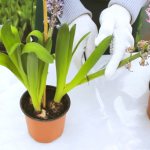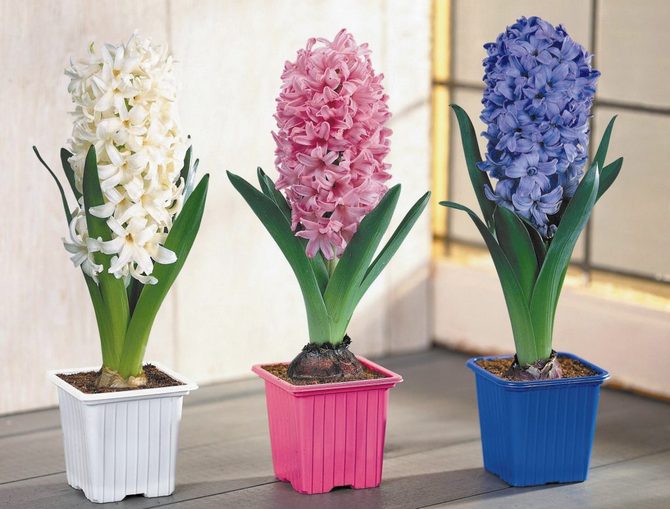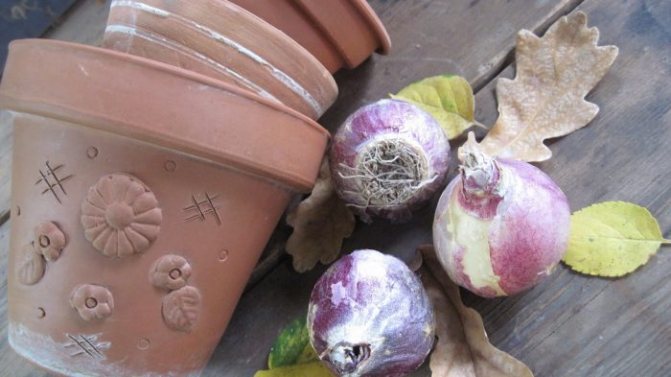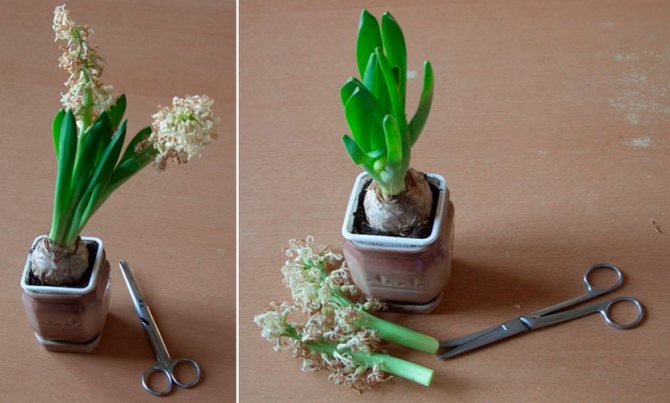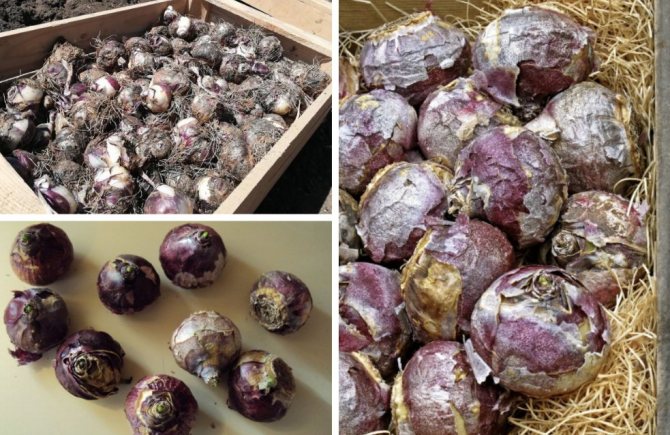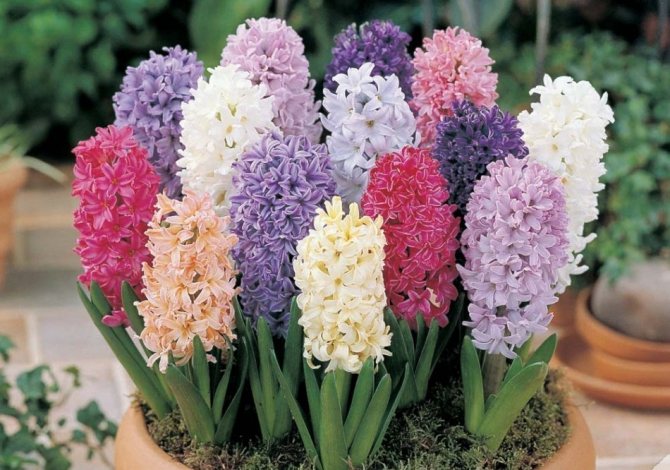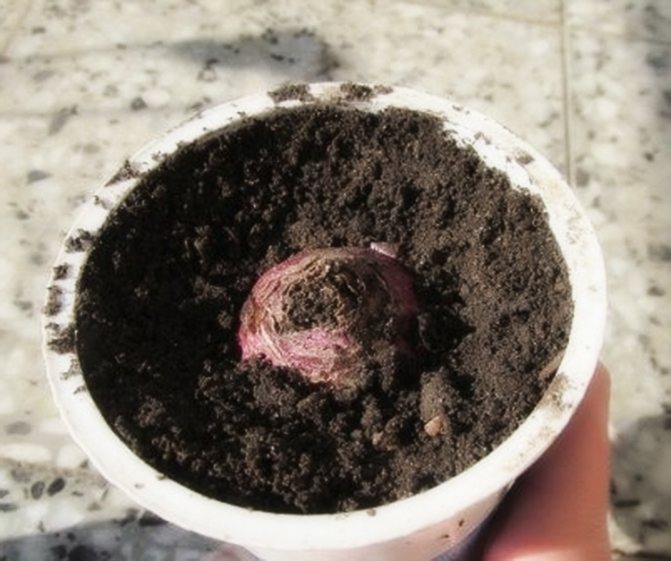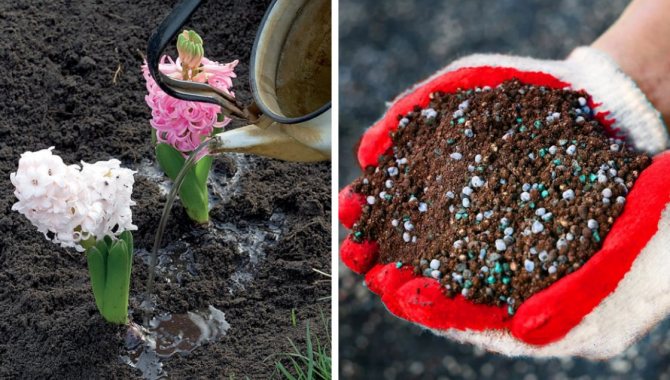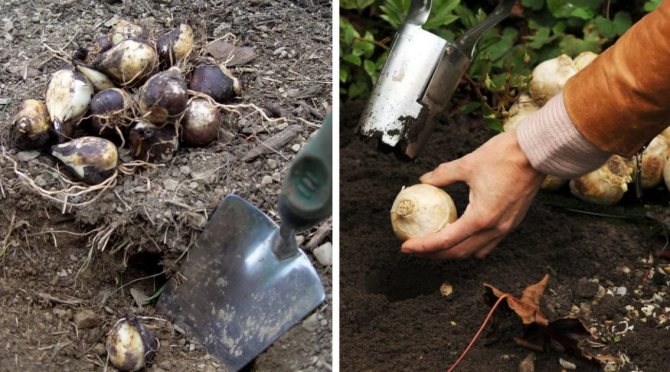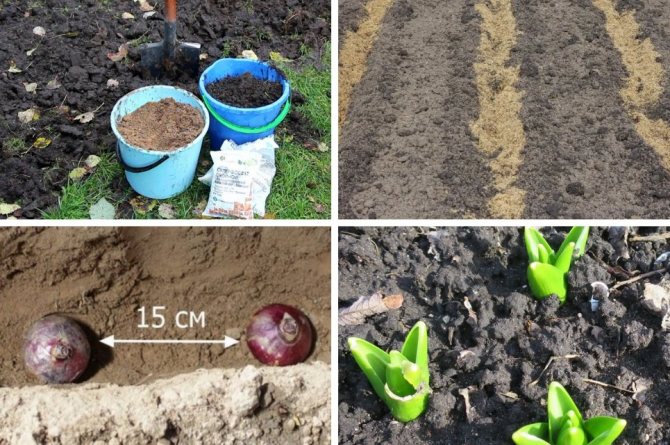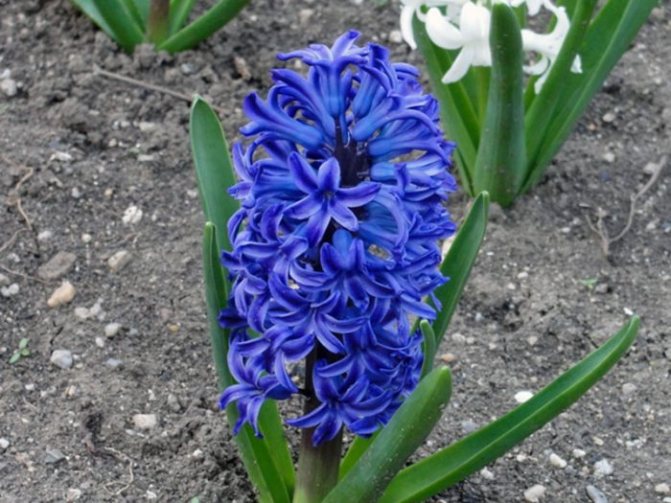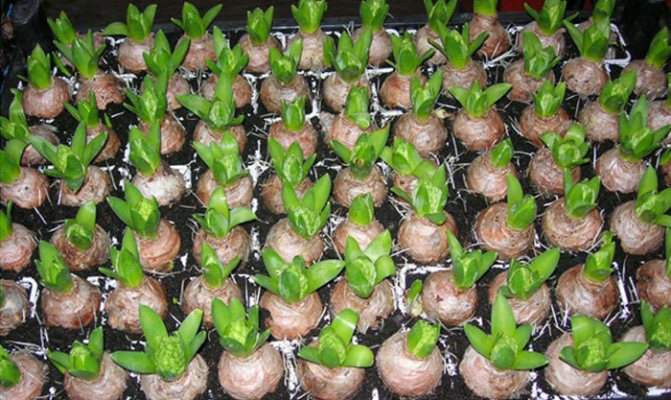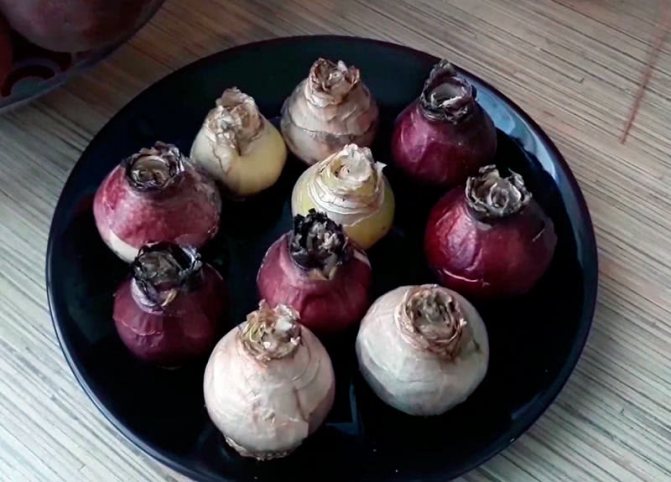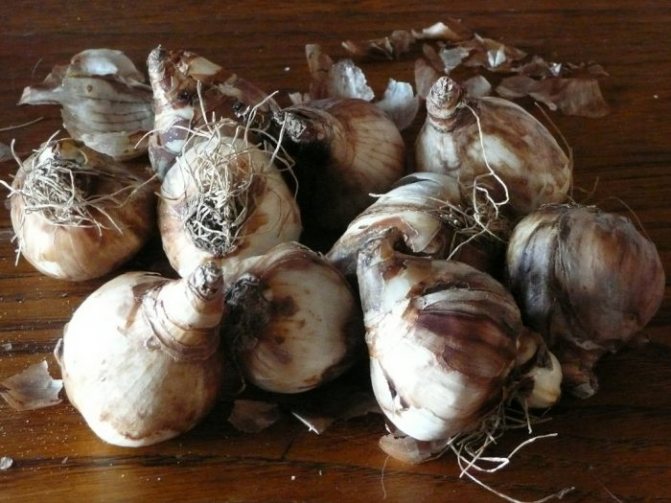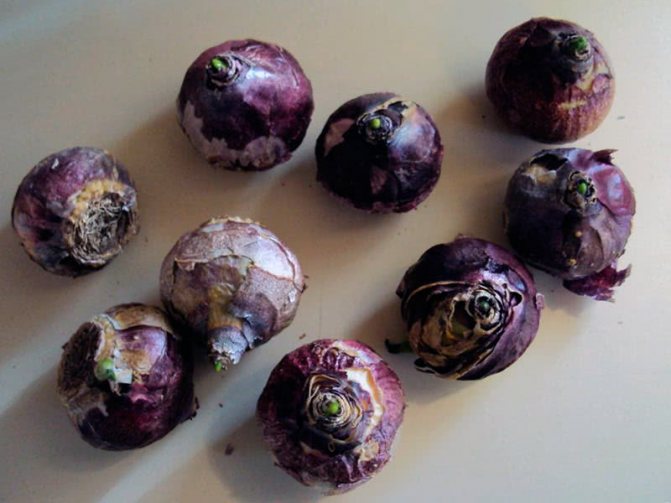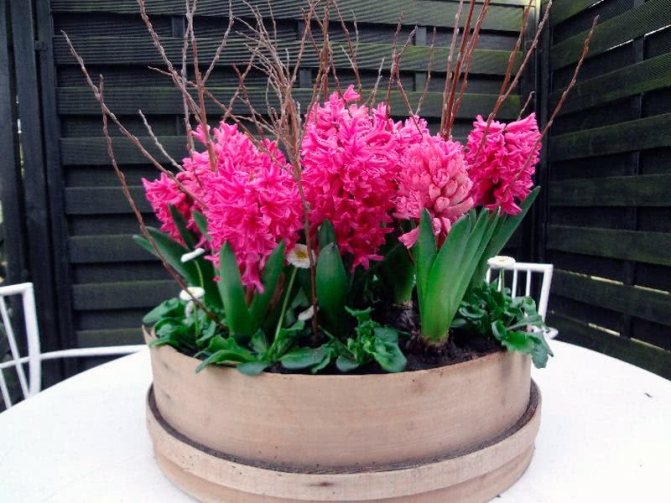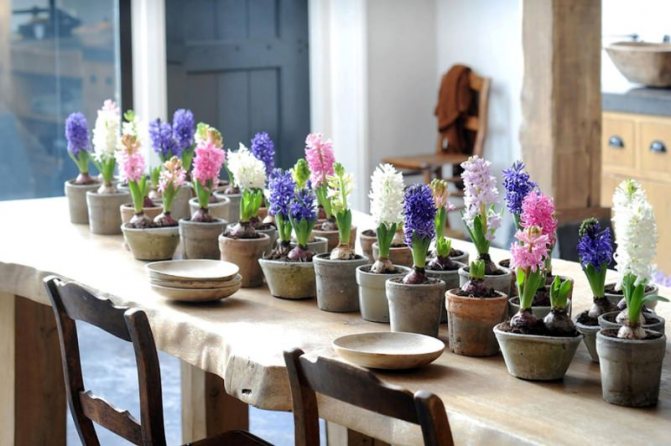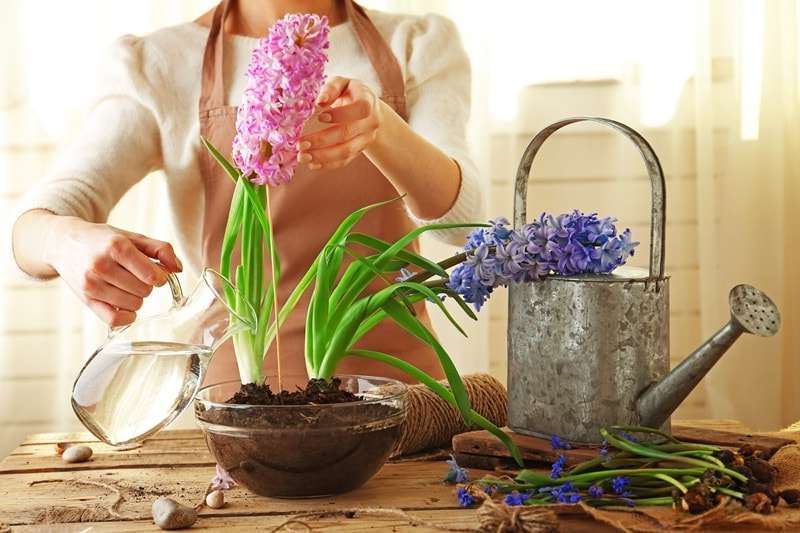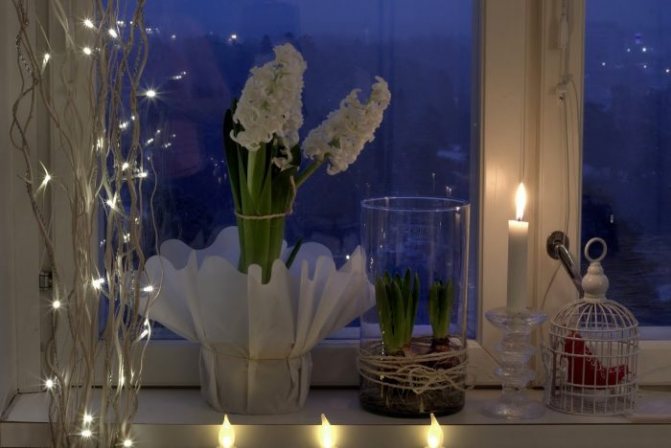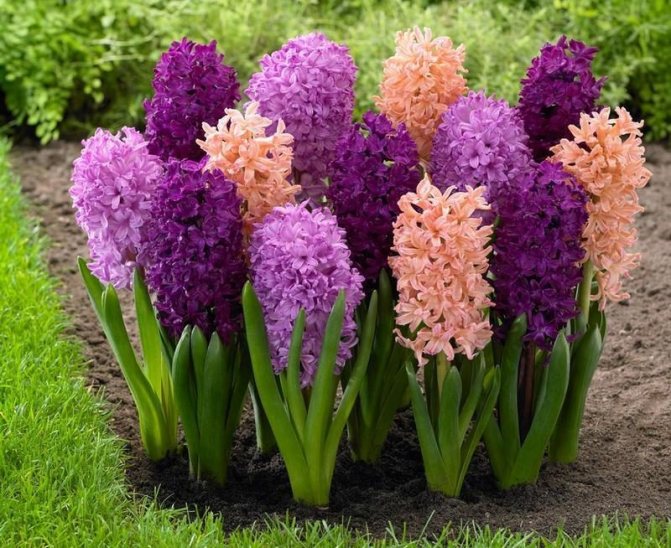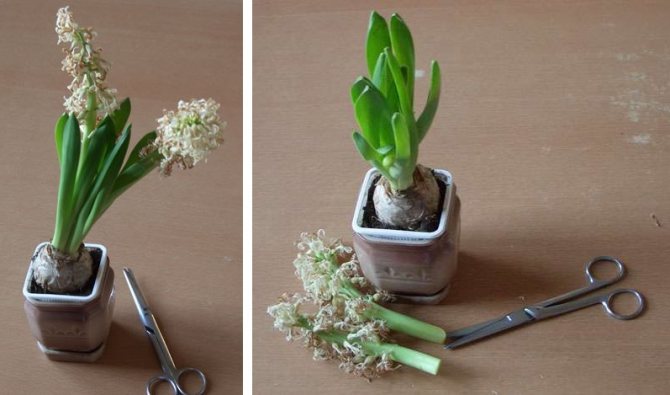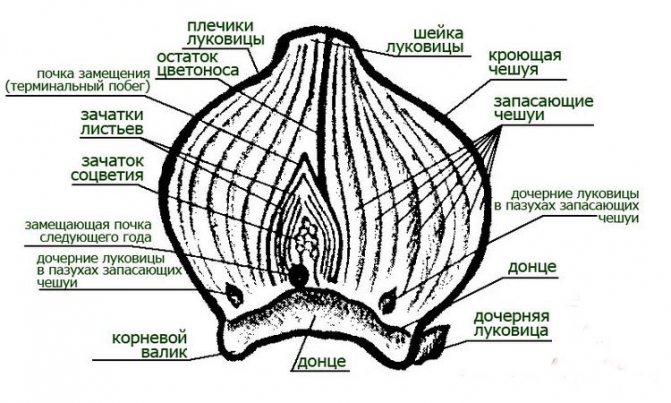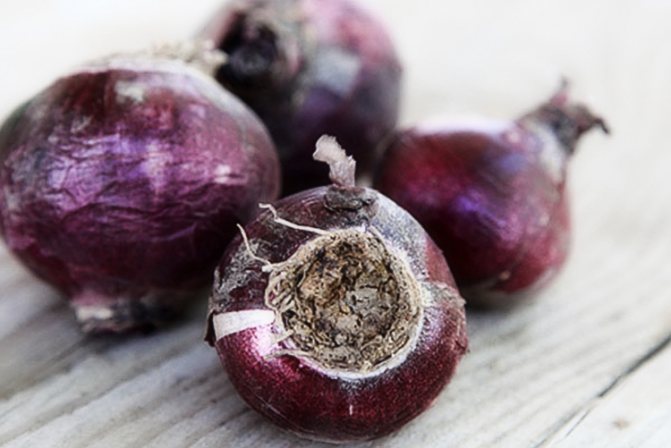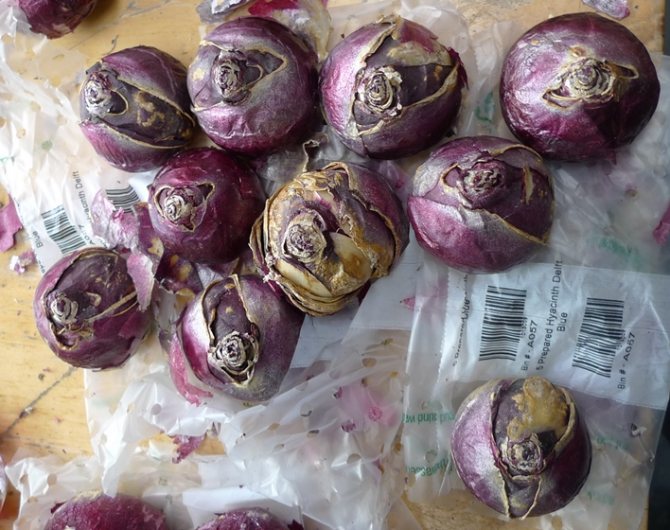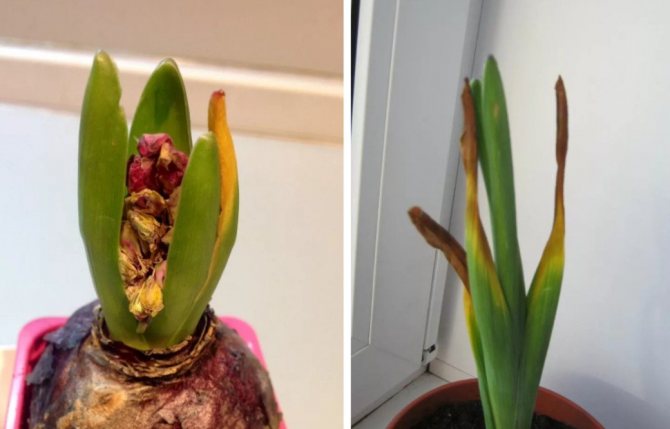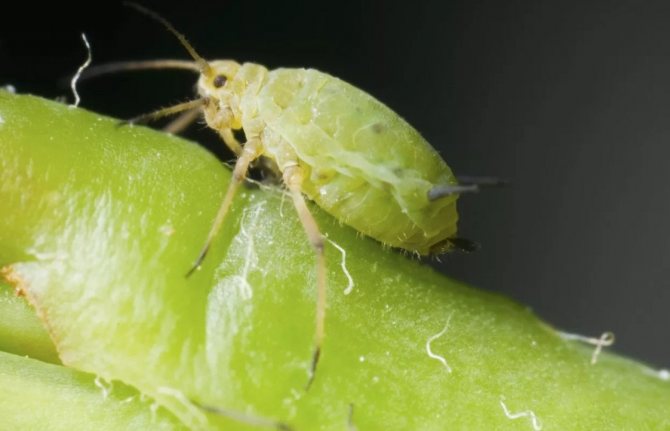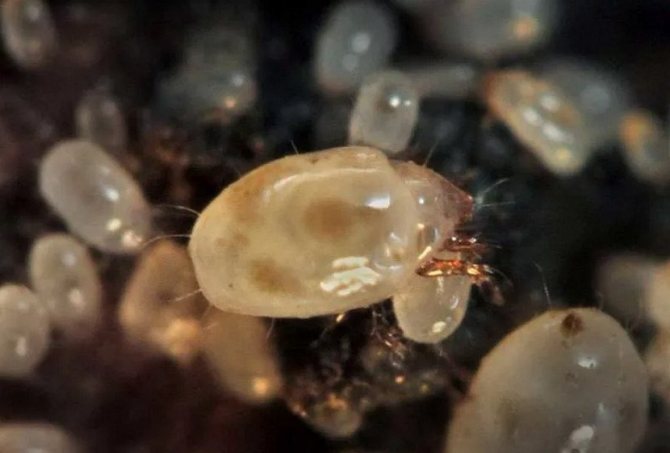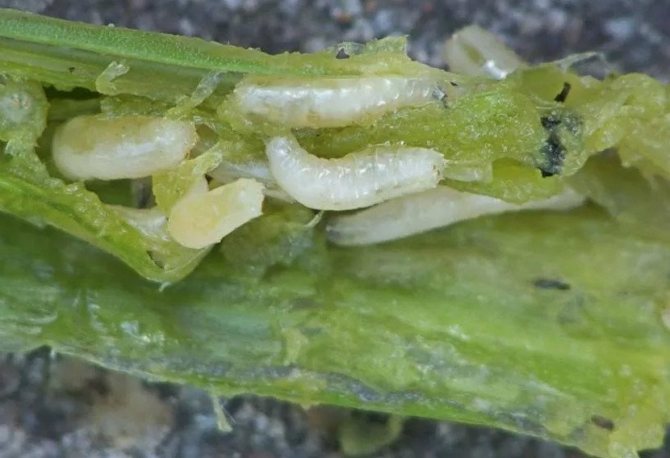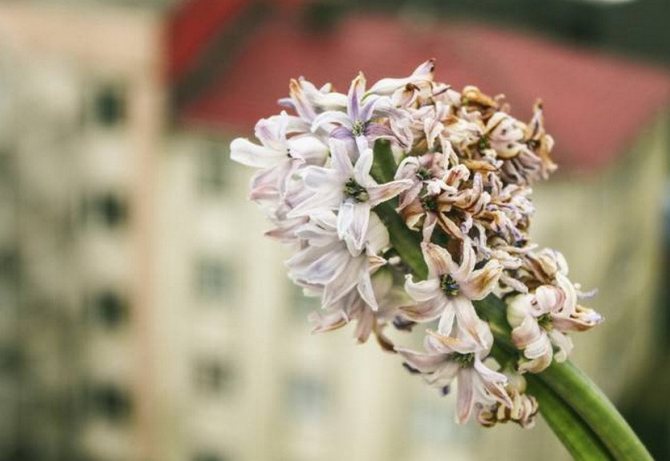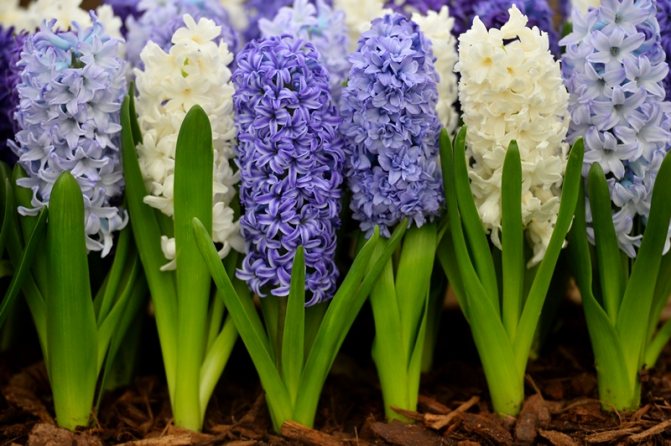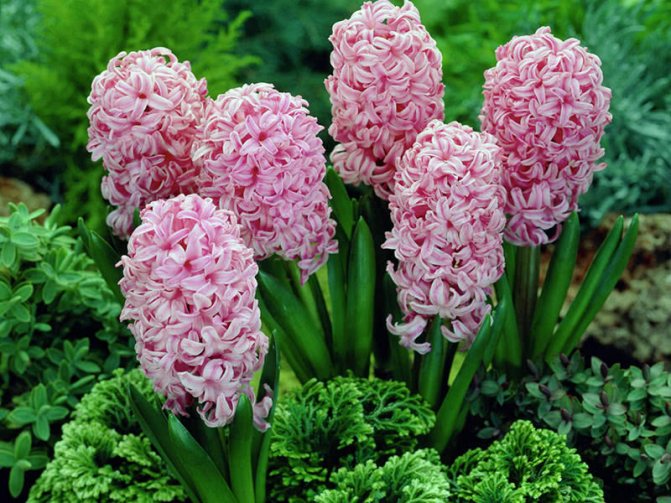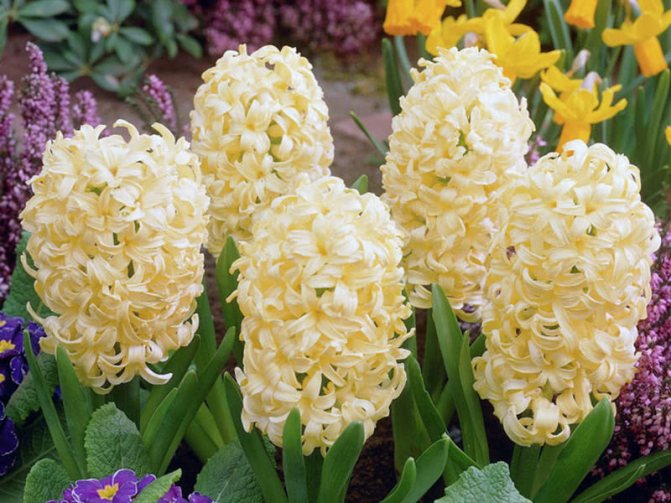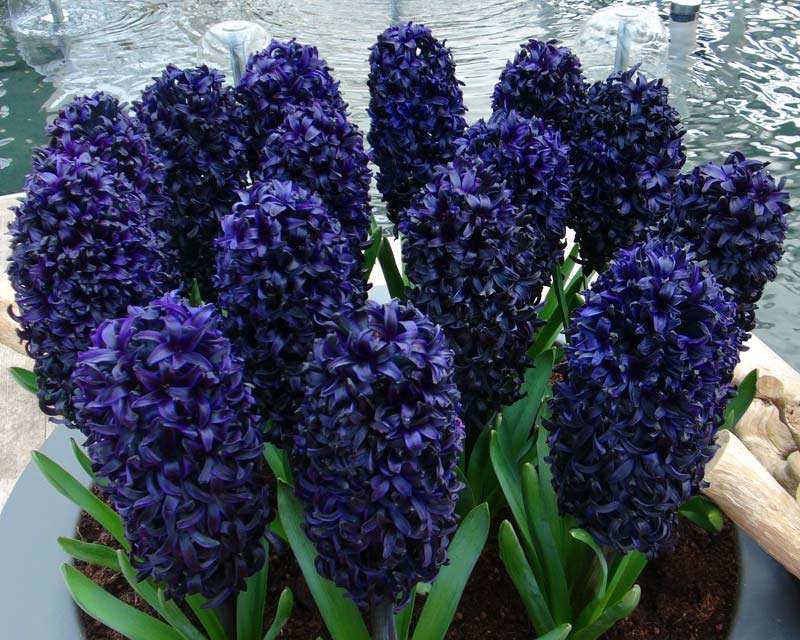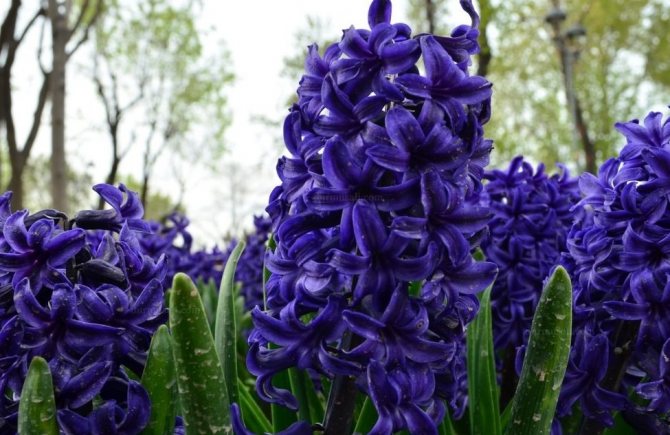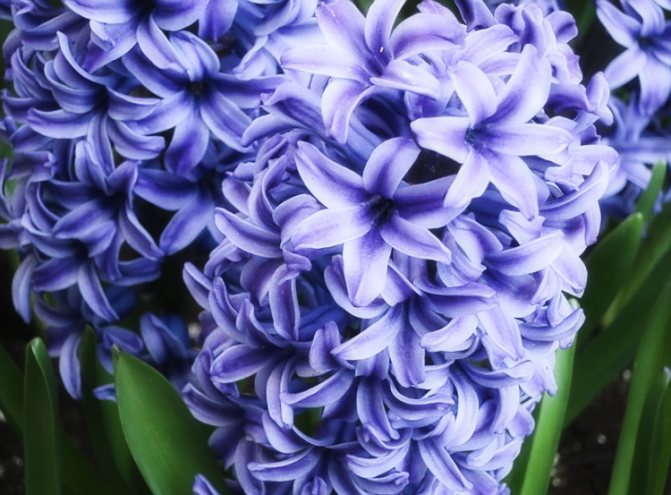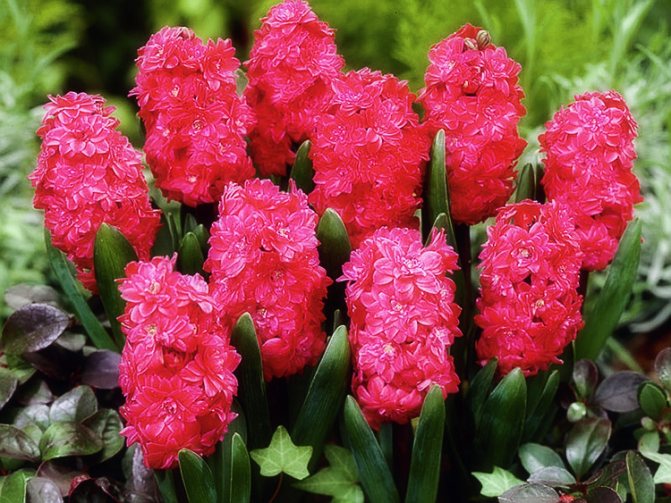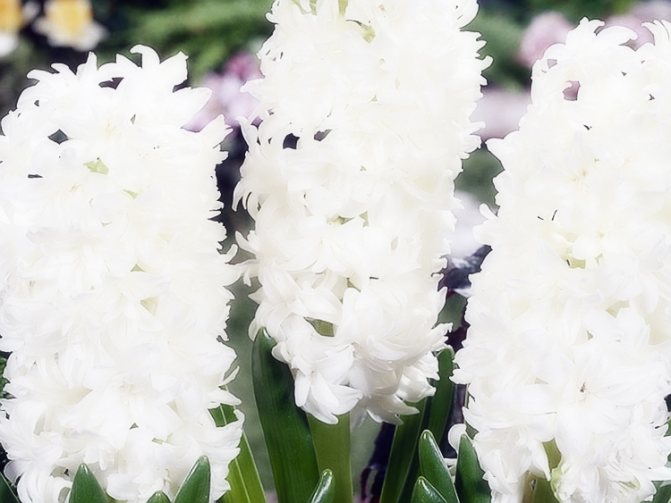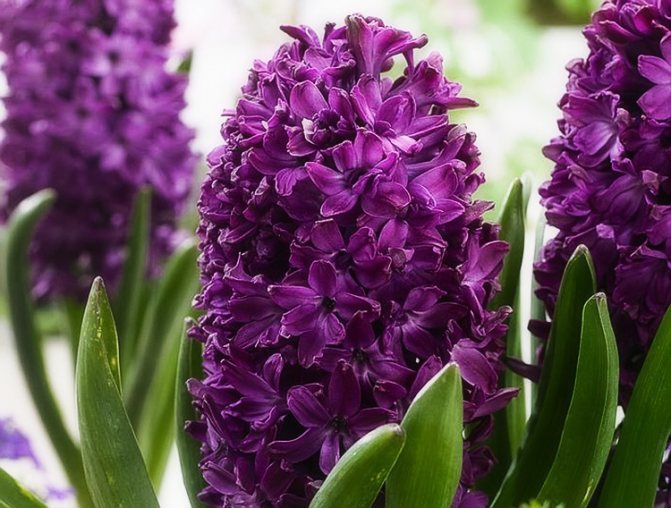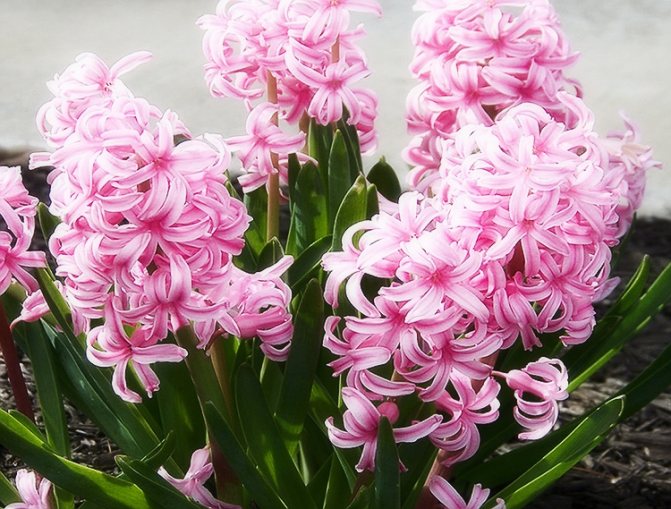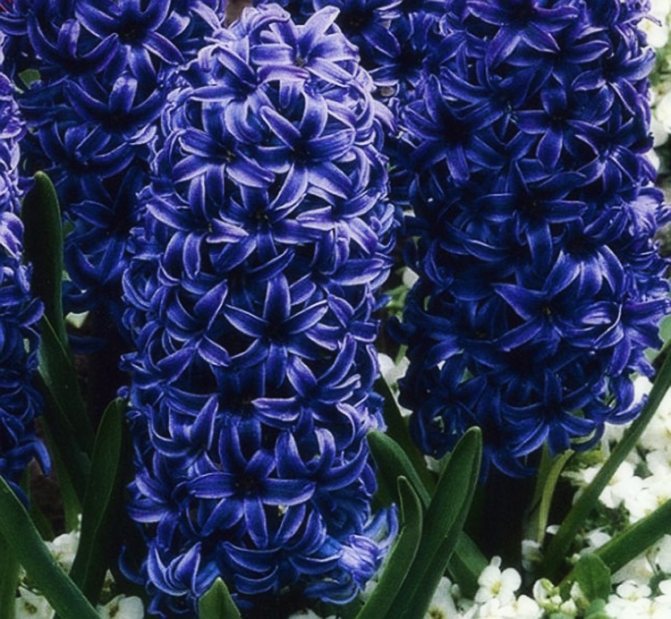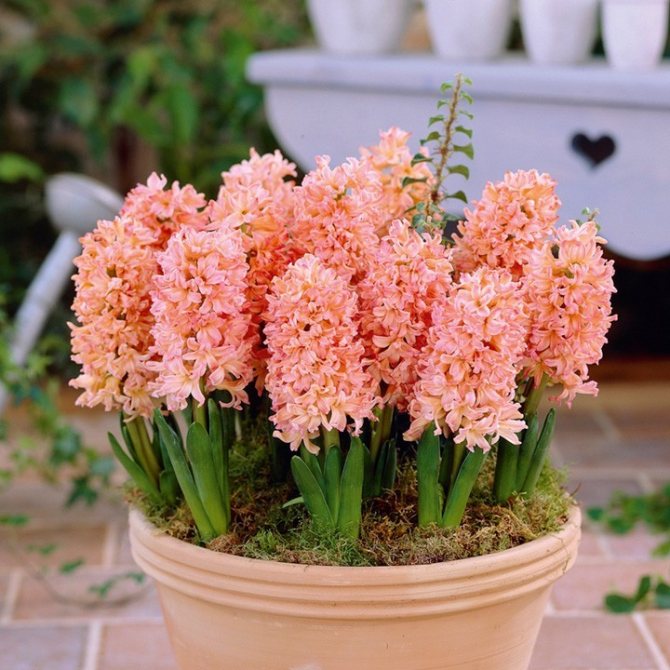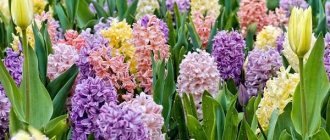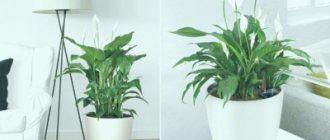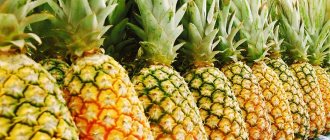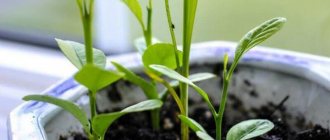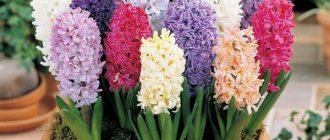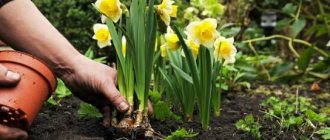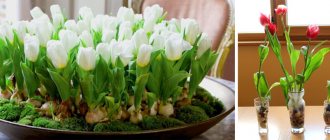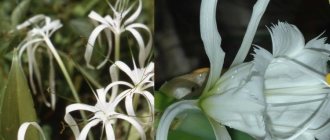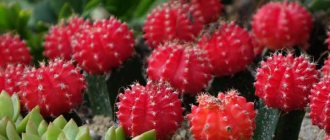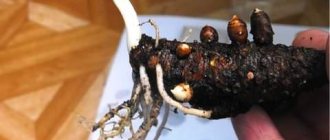14 March 2019 ditim Main page »Reading Views:
For the holiday on March 8, beloved women are often given flowers in pots: tulips, daffodils, hyacinths. It is pleasant to receive such a gift: flowers in the ground delight with flowering much longer than cut flowers. But the natural pattern is that any flowering ends sooner or later. And then the question arises: what to do with the bulbs next, can they be saved?
In Europe, for example, the bulbs of distilled flowers are ruthlessly thrown away - there they are considered disposable. But in the hands of caring Russian women, they are able to bloom again, the main thing is to provide the plants with proper care, to do everything right. So, the hyacinths have faded, what's next? Let's give them a second life!
Bloom
The flowering process of hyacinth can be regulated. It produces flower stalks at any time of the year in the presence of comfortable conditions. At home, the bulb is planted in early September to achieve winter flowering. When planting a tuber in the middle of autumn, the plant will bloom in spring.
Growing hyacinth in a pot begins with the selection of large, dry, fleshy bulbs. Before disembarking, they are kept cool for 2-3 days. For these purposes, use the lower compartments of the refrigerator.
It is possible to extend the flowering period of hyacinths in a pot by placing the plant in a cool place at night.
Conditions for preserving hyacinth bulbs
Dried bulbs are calibrated before storage and treated with drugs against pests and diseases. This can be done in 2 ways: soak in solution or spray from a spray bottle. Fungicide "Maxim" is used more often, dissolving 2 ml in 1 liter of water and keeping the bulbs in it for half an hour, or use another similar disinfecting preparation.
Hyacinths: flowers, plant, home care
Large and small bulbs are stored separately in paper bags, cardboard boxes, signing the names of the varieties.
Additional Information. The outer scales of the bulbs are different in color: in dark varieties they are purple, in light ones they are golden.
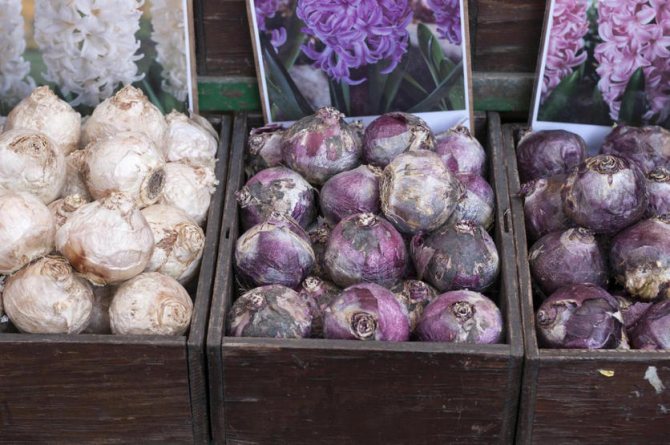
The color of the scales of the bulbs depends on the color of the inflorescencesStorage, during which flower buds are laid, is divided into 2 stages:
- The first, two months, takes place at 25-28 ° С.
- The second, pre-planting, lasts 1 month, the temperature is maintained at 18 ° C, keeping an eye on the air humidity (50-60%). If it is insufficient, the bulbs will dry out, with high humidity, fungal diseases occur.
During storage until autumn, the planting material is periodically examined to identify diseased specimens.
Actions after flowering hyacinth in the open field
After flowering, the hyacinth is cut off the arrow to form seeds. They take nutrients from the bulb, making it weaker. Dutch growers advise cutting off the peduncles of young plants 1-2 years old. The bulb will begin to intensively accumulate nutrients, it becomes larger, and blooms profusely.
In dry weather, the soil is watered so that the tubers do not disappear. Potash or phosphorus fertilization is applied once to wet soil.
What to do with the leaves after the hyacinth has faded? They must be left behind. Nutrients come from soil, irrigation and fertilization. The tuber is dug out after all the leaves have wilted.
A hyacinth bulb can be grown in one area for 3-4 years.During this time, she will get stronger and grow up children. In the fifth year of growth, they are dug up and planted. Some breeders advise not to leave the bulbs of whimsical varieties for wintering in the soil, as they may die or weaken. They are dug up and stored in a cool place.
Interesting! There is a Persian proverb that says that if you have two coins: one is better to spend on bread, the second on the purchase of hyacinth to cheer up.
What difficulties may arise
If you planted hyacinth varieties in a greenhouse and followed all the recommendations, but flowering did not come, several factors may be the reason for this. With excessive watering, the leaves simply wither. When the peduncle is short, it means that you have interrupted the dormant period of the plant. Those growers who did not provide enough lighting for the flowers should not be surprised if the foliage of the hyacinths begins to actively turn yellow.
To prevent this from happening, carefully monitor the growth of spring flowers at every stage. You should not run ahead of the locomotive: you can stimulate flowering only at a certain time, when the plant is completely ready for this. There are also cases when a hyacinth peduncle does not form at all. This means that you did not observe the temperature regime. In some cases, the reason lies in too small and weak bulbs.
Storing the bulb
Hyacinth is planted in September in an open area. But what to do with the bulb before this time? Proper storage will ensure abundant flowering in the spring.
Hyocinth bulb
- The bulb is dried in fresh air at a temperature of 20-22 ºС until all the leaves dry out.
- Free from soil residues, remove old scales.
- Disinfect in a weak solution of potassium permanganate.
- The kids are disconnected. Keep in mind that in varietal hyacinths, the traits are preserved during vegetative propagation.
- Large bulbs are best kept separate from others, as they are less susceptible to disease.
- Store in a cool, dark place.
Hyacinth plant: legends and beliefs
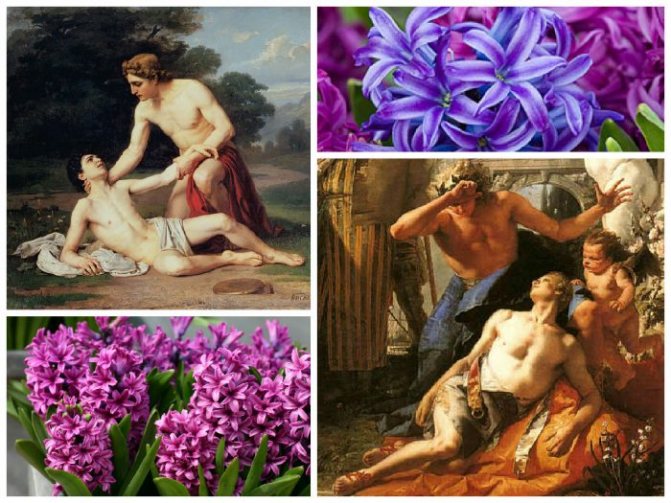

reproductions of paintings-stories about the origin of hyacinths
A number of legends are associated with hyacinths, for example:
- about the handsome young man Hyakintos, at the place of whose death this flower grew. Apollo was in love with the young man, but the jealous Zephyr, the god of the west wind, mortally wounded Hyakintos during his discus throwing training. The name of the flower that appeared at the place of death was given by Apollo himself;
- about the wound of Hyacinth. In ancient Greek society, the person who bore this name was popular and revered. But over time, his glory faded, the god of beauty Apollo eclipsed him. Once they began to compete in discus throwing. Apollo wounded Hyacinth and from the drops of the second's blood that fell to the ground, scarlet hyacinths sprouted;
- about the appearance of flowers off the coast of Holland. After the wreck of the ship, a week later, the children saw flowers and leaves swaying along the shore on the surf. They were hyacinths;
- associated with Ajax's suicide. After the death of Achilles, Odysseus and Ajax claimed the rights to his weapons. The Council of Elders gave preference to Odysseus. Ajax was amazed at their decision and pierced himself with the sword. At the place of his death, hyacinths grew.
Legends are also associated with hyacinths. For example, one of them says that ancient Greek women loved to decorate their hair with them. So they attracted happiness and love to themselves, learned how to curl and style their curls beautifully.
Forcing hyacinths
At home, hyacinth blooms in late winter or early spring. Therefore, you cannot transplant it to the street, since the soil is still frozen. After storage in a pot, the bulb is planted in the fall. In such conditions, the plant does not always manage to survive or bloom next year.
The onion is planted in a container with soil and placed in a cool place. It should look out over the surface of the ground by 1/3.It is allowed to store the bulb on the windowsill of the glazed balcony or in the lower drawer of the refrigerator. With proper care after planting, the plant will delight you with timely flowering.
After flowering, the hyacinth is transplanted into a larger pot with a nutritious substrate. A thick layer of drainage is laid out on the bottom. Moderately watered once a week. The soil is loosened, sand can be added for its ease.
Hyacinth is a light-loving plant, but does not tolerate direct sunlight. From time to time it is necessary to turn it towards the sunny side so that the flower grows evenly. On cloudy days. Due to a lack of lighting, the plant sheds leaves and formed buds.
INFORMATION
Watering should be done through the pallet. The flower does not tolerate moisture on inflorescences, leaves.
Will hyacinth bloom?
Those who prefer to throw away the bulbs that have been distilled are partly right. Hyacinths of Dutch selection are often sold to us in pots, they are characterized by weak winter hardiness. And if there is no flowering next year, the bulb is probably dead.
But don't be in a hurry to get upset. Numerous experience of amateur flower growers (like you and me), were able to achieve flowering bulbs, subjected to forcing! It's just that very often (and most likely) it is not yet time. Forcing is a lot of stress for the plant. Usually the next year the plant rests, gains strength, and blooms only two years after forcing (that is, through the spring).
Landing in open ground
Planting hyacinth in open ground is carried out carefully, without damaging the roots. The bulb is planted with a pointed part, the top is not very deep, slightly covered with soil. The distance between the seedlings is about 10 cm. The plant does not like wind and drafts.
Pre-prepare the site 2 months before the intended landing. They dig up the soil deeply, since the roots penetrate 40-50 cm deep. Lime or chalk is introduced into it. Clay soil is mixed with sand, peat. Fertilized with organic matter (manure, humus, bird droppings, wood ash) and mineral fertilizers. Monitor soil moisture, prevent water stagnation.
Hyacinths can be grown in soil, ornamental pebbles and in water (hydroponically).
The transplant is carried out annually to a new place where other bulbous plants did not grow, since infection with pathogens is possible.
Possible problems
The plant does not bloom, reasons:
- high substrate moisture;
- poor watering;
- bad light;
- keeping the bulb dormant at high temperatures.
Eliminating the problem - the flower will bloom in a couple of months. If the reason is not established, the bulb is dried again, excess scales and areas affected by rot are removed. Place in a dark and cool place, observing the temperature regime up to +5 ºС.
Diseases
Unhealthy leaves with small yellow spots appeared on the plant - a sure sign of spider mite infection. Remove the affected areas. They are treated with a broad-spectrum fungicide.
Leaves do not appear on the plant, buds do not form - the bulb has died out as a result of a fungal disease. The affected tuber and substrate are discarded. The container is thoroughly washed with hot water.
Dark round formations appeared on the underside of the leaves - a lesion with a scutellum. Pests are collected by hand, treated with a solution of insecticidal soap.
Hyacinth vase
INTERESTING
There are special vases for hyacinths on sale, the shape resembles a flower clock - they fix the flower, providing space for the roots.
Hyacinth is a bulbous garden flower that is one of the first to bloom. The color of the inflorescence itself can be varied - from white to dark purple and even black. Growing hyacinths is possible both in the garden and at home in a flower pot.In the wild, this vibrant flower is native to the Middle East and Mediterranean. There are more than 30 species of wild hyacinths.
Distillation does not pose any particular problems. Very often, on the eve of Women's Day on March 8, you can find already blooming hyacinths in flower shops. But you can grow them at home and on your own. If you want to get a flowering plant for the holiday, you need to plant it in the last days of December. For forcing the bulbs, it is necessary to select the largest, full-bodied, undamaged bulbs. There must be a hole in the pot in which the hyacinth will grow. It is necessary to pour drainage at the bottom - it can be expanded clay or any small pebbles, then there is a layer of sand and only then a nutrient mixture, you can buy it in a store or cook it yourself. For this, 2 parts are suitable, peat or humus - 2 parts and 1 part of sand. Hyacinths are unpretentious to the soil mixture and can grow in any. It will be good if you add a few superphosphate granules to the soil for the flower, then you will get a lush bloom by March 8. The bulb should look 2-3 cm out of the nutrient substrate. Hyacinths do not like dry air and high temperatures. The most optimal temperature regime for them is 15-18 degrees. Watering should be moderate, they do not like waterlogging.
After flowering
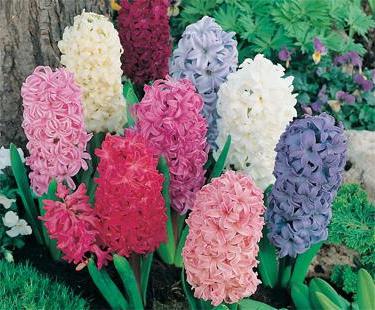

dry, you need to carefully dig up the bulbs, this is if it grew in the garden. Then they must be well dried and stored in a dry place before planting in the ground. If the bulbs are not dug up, they will bloom worse next year. If the hyacinth has faded at home, what to do next with it? There are several options here. You can just throw out the onion and buy a new one next year.
But we are not looking for easy ways and will keep it for further flowering. After flowering, hyacinth should be continued to water, after cutting off the peduncles and preserving the leaves. Watering continues until all the leaves of the flower are dry. During this time, the bulb will recover, gain new strength and grow a little. Next, shake the onion out of the pot and dry well. In the fall, it can be planted in open ground. An onion that has been used for forcing at home should not be reused at home. Its flowering will be meager, and if you plant such a flower in the garden, then it will gain strength there. Such bulbs can be alternated: a year forcing at home, two years in the garden. Hyacinth bulbs can live for over 10 years. further, we figured it out, now we’ll deal with the children.
Reproduction by children
Hyacinth is not very willing to multiply, but sometimes after flowering, children are formed in it. They need to be carefully separated and planted in open ground along with full-fledged bulbs. Such offspring will bloom only in the 4-5th year. But you can help the bulbs to form children. Let's figure it out in order. The hyacinth has faded. What to do next? After the onion has been dug out and dried, a cross-shaped incision should be made on its bottom with a clean and rubbed alcohol with a knife. After each next onion, the knife must be treated with alcohol. When such incisions are dry, place the bulbs upside down in dry cardboard boxes. We store this way until September, by which time 5 or more children are formed on each bulb.
Think hyacinth is a flower? No, this is the name of a young man, beloved friend of the Greek god Apollo. Often the young men had fun by throwing a disc one by one. But the jealousy of the god of the West Winds led to misfortune. And now Hyacinth is bleeding in the hands of a friend - the god Apollo. Apollo could not help him in any way, only in memory of his friend he created a unique flower and named it Hyacinth.
This, it turns out, is thanks to whom many women receive a deliciously smelling gift on March 8. Moreover, there is such a variety of colors: white, pale yellow, pink (any tonality), lilac, blue, blue, red, purple.
The choice of capacity and substrate
Knowing when to plant homemade hyacinths by March 8, you will be able to grow a whole flower garden by this time. However, first you need to take into account a lot of recommendations. For example, choosing a pot for your bulbs is very important. Its height must be at least 15 cm. The diameter of the container will depend on the number of bulbs. Remember that they should not be in contact with each other or with the walls.
It is recommended to fill the bottom of the pot with a drainage layer: crushed stone and sand. The optimal composition of the soil mixture includes humus, turf soil, and coarse sand. Remember to compact the soil well and also water it. Inspect the bulbs carefully before planting. There should be no rot on them.
Growing hyacinths at home
Looking at the hyacinth, everyone will think: “I want it! Want! Want!". If you want, then everything will be, while you have to try. "Hyacinth" is a Greek word translated as "rain flower", perhaps because the grower needs to shed a lot of sweat over its cultivation. This, of course, is a joke, however, one must not only know the peculiarities of growing, but also methodically adhere to them.
Preliminarily, we note that it may be necessary for additional lighting and supports for the peduncles (the inflorescences are too heavy). Our task is to get as close as possible to the conditions of the natural environment - South Asia and the Mediterranean.
Choosing a location, suitable temperature and light
This is a tricky business, as all of the following factors should be taken into account:
- daylight hours need about 15 hours (windows to the south or southeast are suitable, others need additional lighting - prolongation of daylight hours);
- the flower loves light, but not heat - the comfortable temperature is slightly more than 20 ° C - so in summer you will have to remove the flowerpot or shade it from the direct sun;
- does not tolerate drafts or sudden changes in temperature;
- loves walking to a terrace or balcony at the right temperature;
- in winter, the proximity to heating devices is unacceptable.
Creation of the necessary air and soil moisture
Everything is simple here - you must not allow the soil to dry out - on the one hand, rotting of the bulb and leaves - on the other. Watering should be done regularly, along the walls of the pot, without reaching the bulbs. Drain excess water from the pallet. Hyacinth does not need spraying, and during flowering, this procedure is prohibited.
Soil selection, fertilization
The choice of soil mixture is important, a neutral soil is suitable for hyacinth, ideally the use of leaf and sod land, peat, humus and sand in equal proportions. No fresh organic matter. Pre-calcine the earth for 1.5 hours in the oven - for disinfection. For lush flowering, the plant will need strength, which means that feeding is required (with ordinary complex fertilizers for flowering plants). The first time at the beginning of the growing season, then - during the budding period, it is possible a little in the final phase of flowering.
How to choose planting material
The key to a beautiful flowering is a quality bulb. Bulbs should be selected in flower shops according to the following parameters:
- the diameter of the bulb is at least five centimeters;
- there is no damage and rottenness;
- the bulb is dense, not dry;
- the best time to buy bulbs is August.
If you get it, then the stem and peduncle should be erect.
Flowers hyacinths - varieties: aquatic, oriental, mouse muscari, bean curly, wild
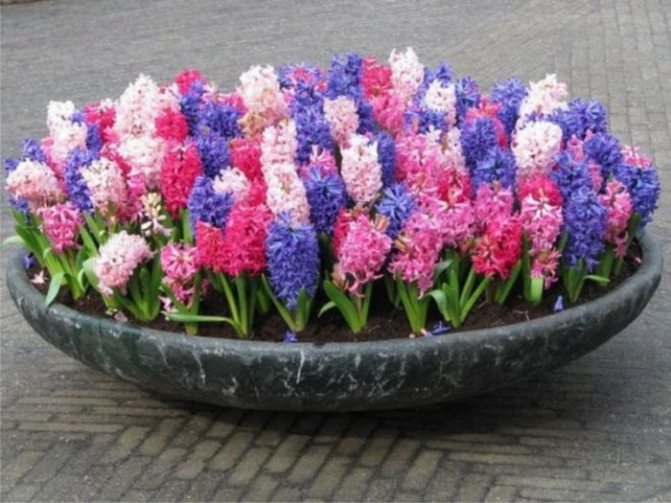

hyacinths of different colors in a large pot
An aquatic species of hyacinths native to tropical America. It grows only in water, while flowers and leaves rise above its surface, and half-meter roots are completely immersed in it.
It blooms in pink, purple and blue hues.Water hyacinth has become ubiquitous due to its interesting properties to purify water from harmful microbes and contaminants, and absorb harmful substances. It can be found in the reservoirs of our latitudes, as well as in aquariums.
Oriental hyacinths have inspired breeders to create many subspecies of this plant in different shades and flower shapes.
The oriental hyacinth comes from Syria, Turkey, Libya. In the wild, it is found in pink, purple and milky colors. The flowering period of the plant is accompanied by a pleasant, strong aroma.
Mouse muscari is a favorite of flower beds and gardens. You can easily recognize it by the shape of the blue or purple flowers. They are:
- look like kegs
- small
- densely and in large numbers are located on the peduncle
This type of hyacinth is unpretentious in care and generous in annual offspring. Each parent bulb surrounds itself with up to 15 baby bulbs.
The curly bean hyacinth is loved by gardeners who are fond of liana-like plants. In a number of African and Asian countries, its fruits are eaten, in all others they enjoy the beauty of the leaves and flowers. The plant is annual, but it easily takes root and grows.
Wild hyacinths are common in European countries. You collected them more than once in early spring in clearings and forests.
Outwardly, wild hyacinth is a rosette of long, pointed at the ends of the leaves and a stem with flowers-bells of 4-10 pieces. Shades of flowers are blue, purple, white. This type of hyacinth has no smell.
Forcing hyacinths How to adjust the beginning of flowering to a specific date?
It can be very roughly calculated as follows: from planting to flowering, it takes about 2.5 months, the plant itself blooms for 10-18 days (depending on the variety), so it is easy to calculate. We want a new year - we start in the middle of October, for Valentine's Day - the end of November, by March 8 - the 20th of December. Before buying bulbs, read the growing conditions thoroughly - the most important thing is that the three phases of forcing require different temperatures (and therefore a different place).
First stage
- we plant the bulb in a pot and simulate winter. We keep the pot for 1.5-2 months at temperatures up to 8 ° C and complete darkening. This can be a cellar, and in the absence of one - the lower section of the refrigerator (close the pot with a package). We proceed to the next stage when the emerging sprout reaches 5 cm. We keep the substrate in the flowerpot constantly moist, drying out is unacceptable.
Second phase
- temperature rise by 5 -7 ˚С (spring comes), the room is still darkened. You can gradually move closer to the window, adding light. We are waiting for the buds to appear.
Stage three
- flowering, takes place in good light and a temperature of about 20 ˚С. The golden rule is no sudden jumps in heat and heat, otherwise you will not see flowers.
Autumn planting
The flowerbed is prepared in advance, a month or two in advance. The soil is well dug to a depth of 20-30 cm, since the roots of these plants go deep. Adding compost or rotted manure to the soil for digging has a beneficial effect on flowering (but not later than a month before planting). You can also fill the soil with autumn complex fertilizer.
In central Russia, hyacinths are advised to be planted in the first decade of October. With early planting, especially if the fall is warm, hyacinths can start growing and die from frost. And 2-3 weeks before frost, the bulbs will just have time to take root, but not germinate. For this, the end of September - beginning of October is considered the optimal planting period.
In autumn, as a rule, in September, the bulbs are planted in the ground to a depth of 1.5 - 2 cm. In general, it is believed that the planting depth of the bulbs depends on the diameter. Large specimens are buried by 18-20 cm, if measured from the bottom. On clay soils, the planting should be shallower. At the bottom of the hole, you can pour a 2-centimeter layer of sand, the hyacinths like this.
The bulbs are lowered into the hole with their bottom down, sprinkled with soil about half of the bulb, and then with soil.
Planting hyacinth at home
We fill the pot with nutritious soil two-thirds in height. No need to tamp.
We plant the bulbs half the height so that the tops are on the surface. So the hyacinth will not get sick with putrefactive diseases and will develop well.
After gently pouring without touching yourself, place the pot in a cool, dark place. When the leaves are 7-8 cm tall, the pot should be placed on a sunny windowsill.
If you have presented the whole process, found places with a suitable temperature - go ahead, plant bulbs. This is a simple matter.
- You can pick up individual flowerpots 5 cm wider than the bulb, or you can place several hyacinths in a container (at a distance of 2-3 cm) - so they look more spectacular flowers.
- It is imperative to place drainage at the bottom of the container, then the earth, do not fill up to the top, so that the planted bulb looks out 2 cm from the soil.
- We plant the bulbs (not close to the edge of the container), tamp the soil and water abundantly.
- A layer of sand (up to 1 cm) can be poured on top to avoid rotting of the bulbs. Everything, we cover it with a dark film (ventilation holes are required) and in the "winter", in the first phase.
When to replant after flowering and buying
Note! Hyacinth blooms in April-May, so it is not transplanted in the spring. A plant transplanted in spring will not bloom.
It is better to plant the hyacinth in open ground in September-early October by treating the bulbs in a fungicide solution before planting. The depth depends on the size of the bulb. When planted in open ground as a street plant, it is completely deepened into the ground.
To preserve the decorative effect of hyacinth, a transplant is necessary after purchase. Indoor hyacinths require frequent transplants because of the limited capacity, in which the roots and growing "babies" become cramped. Another reason is the insufficient amount of soil in the purchased pot. During flowering, the hyacinth is not transplanted, but if you do it carefully, you can save the plant before transplanting it into open ground in the fall.
For transplant, you need to prepare:
- Pot made of plastic or ceramic, 15 cm high and 10 cm in diameter with holes in the bottom.
- Expanded clay, gravel or clay shards for drainage.
- Purchased soil for flowers or a self-prepared mixture of turf, leafy soil and sand.
- Standing water for irrigation.
Additional Information. You need to do the transplant with gloves - the bulb contains toxic substances.
Step-by-step transplant process:
- A 5 cm drainage layer is poured at the bottom of the pot, and sand is poured on top.
- Carefully remove the onion from the old pot with an earthen lump.
- Place in the center of the pot, add soil, making sure that half of the bulb is above ground level.
- Water, avoiding water getting on the bulb.
The transplanted flower is positioned so that it is not exposed to direct sunlight. Sometimes, without waiting for autumn, hyacinth is planted in the garden in May, which will allow it to take root and accumulate nutrients.
Hyacinth at home after flowering
The eastern name of the hyacinth is "Curls of the Hurias". Here they have blossomed, delighted us with their curls, wonderful aroma, now it's time to rest.
What to do with homemade hyacinth after flowering:
- The flower has faded - cut off the peduncle. During the dormant period, we adhere to moderate watering, we give the plant the opportunity to form "children" and gain strength in the main bulb.
- Let's feed the plant with complex fertilizer.
- Only after the leaves are completely dry should the bulb be dug out.
- Examine carefully, air dry, remove dry husks, let too small "kids" stay with "mom", and larger ones can be separated.
- All of them must be thoroughly dried - the first week even at 30 ˚С, then another 2 weeks at 25 С, and before planting - at a temperature of 17 ˚С and high humidity (so that the bulb does not dry out). This is a very important stage, because right now the future inflorescence and small children are being formed (therefore, the next time you plant, you need to be careful not to damage them).
In the fall, hyacinth bulbs need to be planted in the soil in a flower bed so that they can recover from flowering at home. Plant them deeper (15-20 cm) so that they do not freeze, and cover with a layer of mulch of 10 cm. Remove the shelter in the spring. Plants may not bloom in spring, but they will perfectly prepare for the next distillation in the new season. In the fall, the bulbs can be dug up, dried and stored in a cool place until they are planted in a pot. The bulbs can form babies, it is better to carefully separate them and leave them in the flower bed, they will grow for 4-5 years until they reach the size of adult bulbs. Only then can they be used for forcing at home.
Further care
When you have planted your bulbs at home, wait until the dormant period is over. After that, the plant will drop the leaves. This will be a signal for you, since during this period it is advisable to place the sprouts in pots on the windowsill. Watch the intensity of the growth of the peduncle. When it reaches a height of about 15 cm, the paper cover can be removed. To speed up the blooming of the buds, it is advisable to increase the daylight hours and the temperature regime. You control these factors yourself.
During the period of active growth, the temperature should be 20–25 ° C above zero, the air humidity should be 80–90%. The longer the daylight hours and the higher the temperature, the sooner flowering will come, but excessive heat depletes the bulb so much that it may not bloom next year.
How to propagate hyacinths at home
- A faded plant is not suitable for re-forcing at home - it must be planted in open ground (in the fall, even on a flower bed at the entrance) so that it gains strength.
- If you plan to grow it at home again in a year, then this year the hyacinth should not bloom in the soil (you will have to cut the peduncle).
- A small baby can be grown to normal size in 3-4 years so that it is suitable for forcing at home.
- Over the years, the "cubs" will go through the growing season without flowering, gradually gaining strength.
A sensible idea arises here: to get it, buy ready-made planting material, and let them grow it in nurseries.
How to choose a variety and select material
Forcing hyacinths by March 8 should begin with the selection of varieties. Modern selection does not stand still, many varieties of these miniature, but very bright colors have appeared. Nevertheless, your key task is not to choose the varieties that you liked the most, but those that can be grown at home. These include the following:
- Lady Derby. The petals of such a plant have a pale pink tint, and their border is creamy;
- Delph Blue. A delicate lilac or porcelain shade is inherent in this flower;
- Jan Bose. The plant has flowers of a rich crimson color.
When you have decided on the varieties of hyacinths that you are going to drive out by March 8, it's time to start preparing the bulbs, because the process is laborious. If you wish, you can purchase planting material in a specialized store. Here, the bulbs have already been treated with the necessary compounds and are ready for rooting into the ground. However, there are many specialists who prefer to prepare the bulbs for planting on their own. How to do this, we will consider below.
Diseases and pests
The flower is occasionally affected by yellow bacterial rot, with which, alas, nothing can be done.The plant with the earth will have to be thrown out, and if the pot is planned to be used further, then it must be disinfected. Pests can be:
- spider mite;
- nematodes;
To combat them, insecticides are used, however, this cannot be done during the flowering period. Possible problems when caring for hyacinth at home:
- yellow leaves - the draft and watering are to blame;
- leaves wither - lack of lighting;
- falling buds - water hit the buds, a sharp temperature drop;
- cessation of flowering - the flower is hot;
- decay - chronic waterlogging.
Conclusion: hyacinth can be grown with patience and care. Grow smartly and enjoy lush blooms!
Major mistakes
The appearance of the flower can be spoiled by cultivation mistakes:
- Short peduncle: insufficient rest period, too sharp temperature drop, lack of moisture.
- Prematurely yellowed leaves: drafts, poor watering, lack of light.
- Falling buds: lack of moisture.
- Complete absence of peduncle: cold in the room. Sometimes this happens if the bulb itself is young and weak.
As you can see, getting a blooming hyacinth by March 8 or New Year is not the most difficult task. Find a suitable place for a dormant period, follow the rules and adjust conditions as necessary. You will be rewarded with bright and abundant flowering!
Description of hyacinth
Hyacinths photo when to plant at home Hyacinthus orientalis ‘Delft Blue’ photo
Hyacinth is now classified as a member of the Asparagus family, although earlier it was isolated into a separate family of Hyacinths or was ranked in Lileiny. This bulbous perennial is considered a native of Asia Minor, but Dutch breeders have worked so hard to breed its new varieties, to spread the flower and bulbs, that it can be considered a truly modern "Dutchman".
Hyacinth is a plant up to 30 cm high; a stem and oblong leaves grow from a dense bulb. Hyacinth flowers - small bells with twisted leaves - are collected in a dense cone-shaped inflorescence (reminiscent of an ear). The flowers are simple and double in appearance.
At the end of flowering, both the peduncle and the leaves dry up, in the corners of the leaves you need to look for small baby bulbs (you can further use it for breeding), and the main bulb develops on the stem inside the mother bulb. It has proven itself perfectly at home, also in the open field (where it is one of the first to be shown from the ground in spring). This is not unfounded, it is said by more than four hundred years of experience in breeding hyacinths. During this time, about 30 species were attributed to this species, including half a thousand different varieties of plants.
However, today there are three types of hyacinths:
- eastern (Hyacinthus orientalis);
- Litvinov (Hyacinthus litwinowii);
- Transcaspian (Hyacinthus transcaspicus).
It is on their basis that all the variety of shapes and colors of these plants is created.
Do you need to dig up hyacinths every year?
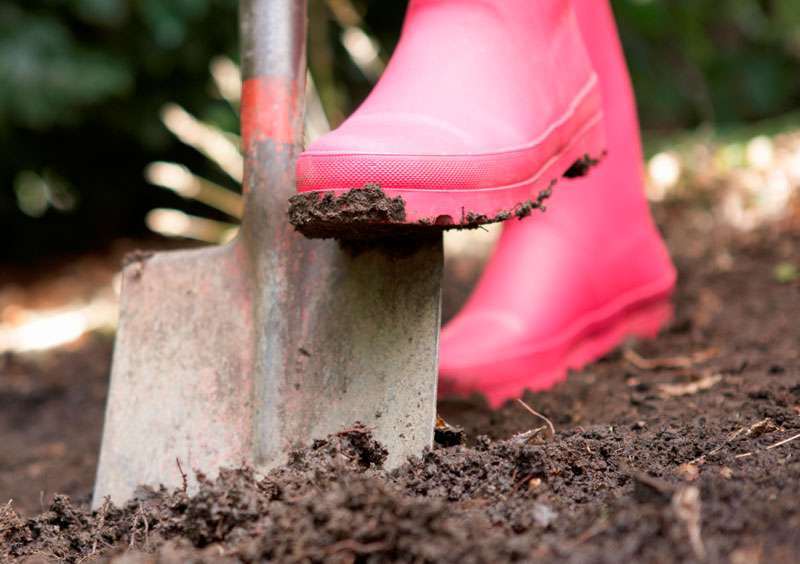

You don't need to dig out hyacinths every year, but leave them in the flower bed. In the natural environment, no one digs hyacinths for subsequent planting - they grow and develop well without additional human participation for up to ten or more years. Then why bother digging up hyacinths at all?
There are many reasons for digging the bulbs annually, namely:
- During digging, the bulbs are rejected and subsequently disinfected with special solutions.
- The grown children are separated, thereby increasing the seed.
- Bulbous plants rest under certain conditions and temperatures, and recent weather conditions have been unpredictable.
- The next argument in favor of digging is rodents. They love to eat root vegetables. Until the next flowering, hyacinths may simply not survive - they will eat it.
- Excavation and subsequent proper storage stimulates flowering well and the setting of flower buds.
In addition to the above, it is worth paying attention to the fact that the transplantation contributes to the preservation of the decorative qualities and varietal conformity of this or that hyacinth variety, preventing them from going into a "wild" state in which the plant begins to degenerate.
Types and varieties of hyacinth with photos and descriptions
Oriental hyacinth Hyacinthus orientalis
- the same great-grandfather of most of today's varieties. Flowers with a delicate aroma are loosely placed on a thin peduncle. Can be any of the shades of white, yellow, pink or blue. In the wild, you can meet in Lebanon, Turkey or Syria.
Hyacinth Litvinov Hyacinthus litwinowii
- has bluish leaves and light blue flowers with protruding stamens. Natural area - Iran, Turkmenistan.
Transcaspian hyacinth Hyacinthus transcaspicus
- undersized flower (up to 20 cm), has up to two stems, leaves equally thickened along the entire length. There are no more than a dozen flowers in a loose inflorescence. Natural place - the mountains of Turkmenistan. Another classification of hyacinths is their division by color:
- - Arentine Arendsen (white or cream flowers), double Snow Crystal and Madame Sophie;
- - Yellow Hammer (deep yellow), Oranje Boven (pale yellow), City of Haarlem (salmon);
- pink - Anna Marie (light pink), Gertruda (deep pink), Moreno (pink with a dark raspberry stripe);
- red - La Victoire, Tubergen's Scarlet, Hollyhock (terry);
- lilac - Bismarck (pale), Blue Magic (red-purple), Indigo King (dark purple);
- blue - Queen of the Blues (light blue), Perle Brillante (pale blue), Marie (deep blue).
In winter, a large selection of distilled hyacinths appears in flower shops. Large bulbs with green leaves and a flower stalk ready to bloom are purchased to decorate an apartment or as a gift. Two weeks later, when the hyacinth has faded, what to do at home? The main thing is not to rush to stop watering and cut the leaves. You can store the bulb until fall and plant it outdoors or in a large pot.
Hyacinths - bright flowers with a fragrant aroma
Digging up the onion
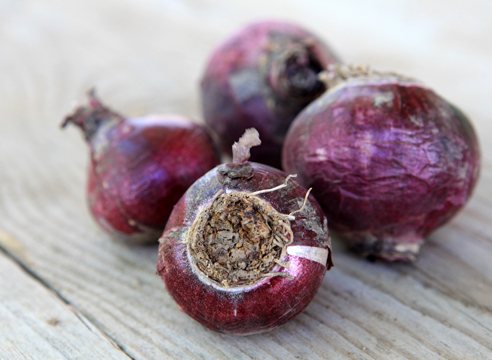

When the leaves dry up and die off completely, after pruning them, you must take the bulb. After about two weeks after the complete cessation of watering, the soil in the pot dries up completely, and the bulb itself becomes denser. Immediately after flowering, the bulb cannot be dug out - it is necessary to give it time to "ripen", to be nourished with useful substances.
In due time, the tuber must be pulled out of the ground - this must be done as carefully as possible. Then the onion is cleaned of dirt, and removed for drying in a place with a temperature of about +30 degrees. The room where the tuber is dried must be well ventilated.
After drying, you need to move the bulb to fresh soil. In terms of volume, the container into which the transplant is carried out must be larger than the previous one.
The following soil substrate is suitable:
- sod land;
- sheet;
- humus and compost equally;
- some sand to make it friable.
It is also recommended to add a little nitroammophoska (1 tbsp) or complex fertilizer to the substrate.
The bulb is dropped into two-thirds of the volume (the top should be visible from the ground). If you bury the tuber too much in the pot, it can simply rot underground. The edges of the onion should not touch the sides of the pot. The tuber is watered as it needs nutrition.
After transshipment, the bulb, along with its new "home", is placed on a well-lit windowsill. A warmed, light-flooded loggia is also suitable. The bulb will soon take root and begin to quickly form a new green mass. Then it will bloom: if possible, we recommend moving it to open ground. Well, or at least on the balcony, veranda. In mid-July, the bulb is dug up and, having prepared, is stored until the next forcing and flowering.
Watch a video on how to properly prepare and preserve a hyacinth bulb after flowering.
What to do with hyacinth after flowering in a pot
Hyacinths are perennial bulbous plants donated to humans by the nature of the Mediterranean and Central Asia. Compact bushes with beautiful bright inflorescences and a pleasant aroma have moved from garden beds to apartments. The practice of forcing hyacinths in pots for the holidays has spread.Bulbous plants have a short period from awakening to flowering. A technology has been developed to speed up their vegetation.
Interesting fact. The outer scales of hyacinth bulbs repeat the color of the flower in their color. In purple varieties, they are purple, in whites they are light golden.
Hyacinths begin to bloom in February-March, although in the middle lane they bloom not earlier than April. While there is snow outside, they delight with spring aroma and beautiful inflorescences. There are plants painted in pink, burgundy, purple shades. Their flowering period will not last longer than two weeks. After the end of the flowering of the hyacinth in the pot, you will have to decide what to do with it next.
Initially, a flower grown using forcing technology is considered disposable. He spends a lot of energy on early vegetation. But if you wish, you can extend its life. A wilted peduncle is cut off, but not completely. He, along with the rest of the terrestrial part, participates in the accumulation of nutrients. Removing the arrow is not only related to the decorative component. After flowering, seed formation begins, depleting the plant.
The wilting of the peduncle means the beginning of an important cycle - preparation for the next growing season. After the hyacinth has faded, what to do with the bulb? It is dried and stored until the autumn planting in the ground.
What to do with leaves
After the flowering of the plant stops, it is necessary to wait until the last peduncle dries up and cut the leaves. By the time of pruning, the foliage should already be thoroughly dried.
The foliage must not be removed immediately after the plant has faded. Their natural wilting will signal that it is time to dig up the bulb. If you cut off the leaves immediately after flowering, then you can make a mistake with the time of digging the bulb and get it out of the ground unripe. Such a tuber is poorly stored and may not bloom next year.
If forcing in spring, it is recommended to keep the hyacinth together with the leaves in a pot until July. To do this, you need to put the container in a dark place and water it regularly, but not too abundantly. Gradually, watering is reduced, bringing the soil to dryness, and the foliage to natural wilting. Then cropping follows.
But the arrow must be cut off literally immediately after flowering, since it does not allow nutrients to accumulate in the bulb, thereby weakening it. And when the peduncle is gone, the tuber will be able to accumulate enough nutrients by the time of wintering, it will become thick and "well-fed".
There is nothing particularly difficult in trimming the green part of the flower: you just need to separate it, if possible, in one cut using a sharp knife or secateurs. Cut off the green part about one centimeter from the top of the onion.
Hyacinth care after flowering
Hyacinths are usually sold in small pots with a minimum of soil. In such conditions, it is difficult to get good nutrition. You should feed the flower with fertilizers. Special formulations are used for bulbous plants in dry or liquid form. For example, "Hera FlorHumate" is a complex fertilizer with nitrogen, phosphorus, potassium, a set of other microelements. It is made on the basis of humic extract. The dilution rate is 10 ml per 1 liter of water. Top dressing is carried out 1 time.
Information. If the leaves are trimmed and the bulb is dug up before ripening, it can deteriorate during storage.
After flowering, hyacinth remains green for about a month. At the end of this period, watering is reduced, the soil is moistened only after the top layer has dried. The green succulent leaves will gradually begin to wither, turn yellow and dry. This is a natural process, do not worry about the health of the plant, it prepares for summer holidays. Further, the growers act according to various scenarios:
- Hyacinth is planted in May on the site.
- Leave the bulbs to dry and store until autumn planting in the garden.
- A spacious pot or container is selected for growing a flower at home.
Advice. If you decide to plant hyacinth in the spring, then use the transshipment method. Remove the plant from the pot along with the soil. Prepare the soil in advance: apply fertilizer, arrange drainage.
Advice
Several important recommendations that will help you grow hyacinth more competently.
If there are children
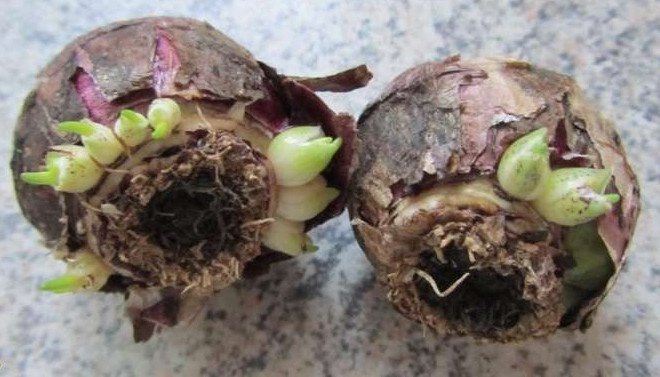

In a hyacinth growing at home in a pot, babies do not appear often - that is why their appearance is even more joyful. In this case, it is necessary to move the plant with the children to a larger container. Moving is carried out only by transshipment and very carefully.
Large baby onions can be separated from the mother plant, stored and then planted as independent flowers. It is better to leave small onions with the "mother" so that they grow stronger: in this case, the separation is carried out next year.
Important: keep in mind that the species characteristics and color are preserved in the children of varietal hyacinths. Hybrids do not.
The foliage turned yellow
This happens after flowering, when the plant needs to retire. If the leaves start to turn yellow, stop watering and soon you can put the plant away for storage.
If the bulb is not dug up
In this case, there can be several options for the development of events: both good and not so. In case of a positive outcome, the bulb will overwinter safely underground and in spring it will start to grow.
The second phase of flowering of the plant is also possible - at the end of summer. Note, however, that if the hyacinth blooms again in the current season, the decorative period will turn out to be "compressed": not too lush, bright. In addition, secondary flowering deprives the plant of energy, knocks out of the schedule and does not benefit its body as a whole.
If you do not dig up the tuber in a row for several seasons, the hyacinth will stop blooming altogether. The thing is that when digging, the children are separated and deposited in other pots. If the tuber is not disturbed, the children will take away all nutrition from the mother plant, as a result of which the hyacinth will not be able to develop normally. In addition, distillation pretty much depletes the plant, and transferring it to a large container with nutritious soil helps it "come to its senses".
If the hyacinth is sick
When forcing the plant, small yellow spots may appear on the leaves of the hyacinth, gradually becoming brown. The symptom suggests that the plant is affected by a spider mite - both a home flower and one growing in the garden can become infected. If a problem occurs, the stained leaves are removed and the plant is treated with a suitable effective fungicide.
When a scabbard is affected, characteristic dark round spots appear on the leaves. The symptom usually appears on the lower part of the leaves. In this case, the visible pests are removed by hand, and then the hyacinth is treated with a soap solution with insecticidal additives.
If you dug a bulb from a diseased plant out of the ground, do not put it together with other tubers. It is necessary to thoroughly disinfect it first and remove the spoiled, rotten parts. Dry such specimens separately from healthy planting material. It is better to store it separately too.
Bulb does not germinate
This happens if the tuber died out due to a fungal disease. In order not to spread the infection, it is recommended to throw the bulb together with the ground. The container, where the onion was located, must be thoroughly rinsed and disinfected.
We learned what to do with hyacinth after it fades. If you need a plant, the best option is to continue growing it, taking into account the peculiarities of agricultural technology. The tips given in the article will help you grow a beautiful bright hyacinth without problems and difficulties and properly store it during a dormant period.
How to preserve a bulb after flowering
After waiting for the leaves to dry, you can take the bulb out of the pot and cook for storage. She will need 90 days to rest and create a bud of a new peduncle. They act according to the following algorithm:
Advice. During storage, it is necessary to provide the bulb with a humidity of 50-60%. Exceeding the indicators leads to the occurrence of a fungal infection, and at low humidity the tuber dries up. Periodically, it is worth examining it to notice the appearance of the disease.
Autumn planting in the garden
- a lot of sunlight;
- water does not stagnate;
- there is wind protection.
Hyacinths require a fertile soil with a loose, breathable structure. Any soil will be improved by a mixture of sand, peat, leafy earth. Complex fertilizers are necessarily applied to the ground. The best time before planting hyacinths in open ground is the beginning of autumn.
The bulbs are preliminarily examined, damaged and diseased ones are discarded.
Planting depth is 15-20 cm, it depends on the size of the corms. The same distance is left between the flowers. they need room to get enough nutrients. A good result is provided by a sand jacket device. The bulb is covered from below and from above with sand, which protects from excess moisture. The plant will take two weeks to take root in a new location. To protect it from winter frosts, dry leaves are poured on top, spruce branches are thrown. In the spring, the shelter is removed.
Planting the bulbs on a sand cushion is recommended
Planting hyacinth at home
If you do not have your own plot for growing flowers, it will be successfully replaced by a balcony. The hyacinth will need a pot 15-18 cm high, the diameter of which is 5-6 cm larger than the circumference of the bulb. At the bottom of the tank, a drainage layer of expanded clay or gravel is arranged. The pot should have holes to remove excess moisture. It is recommended to prepare the soil yourself. This will require:
- leafy land;
- compost;
- humus;
- peat;
- sand.
The components are taken in equal proportions. The result is a light soil with neutral acidity and good air permeability. Alternatively, you can buy ready-made universal soil with biohumus. Phosphate fertilizers are added to the soil before planting the bulbs.
Hyacinths are grown in clay pots
Hyacinths are not completely buried in the ground as in the open field. About a third of the bulb remains on the surface. You can plant several hyacinths in a container at a distance of 3 cm from each other. When blooming, they form a small flower bed. Store the pot in a cool place. Flowers germinate in a dark place at a temperature of 5-7 °. Home-grown hyacinths require more maintenance. They need to be fed and watered regularly.
Growing in a garden or flower bed is the best option for hyacinth. But in spacious pots and containers placed on a balcony or terrace, they feel just as good.
Hyacinth is a bulbous spring flower. He is one of the first to become a garden decoration or and bloom longer than others. You can get pleasant emotions without leaving your home if you put it in a pot. But when hyacinth has faded, what to do with the bulb
? This is the most frequently asked question regarding the cultivation of this flower. It's time to find out the correct answer.
Preparatory procedures and landing
Unfortunately, not all of our citizens can use greenhouses to grow the flowers we are describing, and for them the only way to get hyacinths by March 8 at home is to grow them in flower pots. To do this, first select a suitable pot, the size of which directly depends on how many plants you are going to grow in it.
In any case, such a container should be at least 15 cm high. Drainage from a mixture of shards, pebbles and coarse sand must be laid on its bottom. It is necessary so that the water does not stagnate in the pot during watering.Otherwise, the bottom of the bulb will rot.
As for the question of when to plant hyacinths by March 8. In order for you to get a blossoming flower in March, you must plant the bulb in the ground in early November. If flowering begins earlier than your intended time, there is nothing to worry about, since it will last at least two to three weeks. At the same time, when deciding when to plant hyacinths by March 8, you must also take into account the plant variety.
After you complete the preparatory procedures, you need to move on to planting flowers. To do this, you need to pour a light soil into the pot, consisting of a mixture of high-moor peat and sand in a ratio of 2: 1. Immediately before planting, small indentations are made in the ground, where the bulbs are placed, while they should not touch each other.
Further, the bulbs are filled up in such a way that the top of them necessarily protrudes above the ground. At the same time, they do not need watering, the moisture that you perform before planting hyacinths in the ground is enough. After that, the pot with bulbs is placed in a dark place for 2-3 months. It should be cool with a temperature of 4-6 ° C. This will allow the bulb to take root.
The best place to find a pot with an onion is in the refrigerator or a cool closet, as this is the easiest way to control the growth process. At the same time, try not to flood your hyacinths, just moisten the soil a little, or it is better to completely abandon watering at low temperatures, since the bulb can rot from excessive moisture. For the same purpose, do not put a plastic bag on top of the pot.
Let's take a look at how to prepare the bulbs and what kind of inventory you need.
The success of forcing also depends on the type of plant.
The early varieties are planted in late October and bloom in December-January. These include:
- Marconi;
- Bismarck;
- Delft Blue;
- Blue Magic;
- Anna Marie.
Medium forcing implies planting the bulbs in early November and blooming in February-March. Suitable varieties:
- Lady Derby;
- Blue Jacket;
- White Pearl;
- Blue Sky;
- Orange Bowin.
For late forcing, the bulbs are planted in December and flowers in April. Late varieties include:
- Anna Lisa;
- Woodstock;
- City of Harlem.
Soil selection
The soil should be light and loose. It is prepared from humus, coarse sand and sod land in a ratio of 2: 1: 4. Another option: sheet earth with sand or perlite.
Several small pieces of charcoal or crushed activated tablets are added to the mixture, which helps purify water, and also prevents the development of harmful microflora.
Perlite, expanded clay or crushed stone can be used as drainage.
Suitable pots
Hyacinths need pots about 15 cm tall. The distance between the bulb and the edge of the pot should be no more than 2–2.5 cm, otherwise the plant will spend most of its energy on the formation of children, and not on flowering. You can plant several bulbs at once in a wide pot.
Preparing the bulbs
Hyacinths need a rest period before forcing. After the leaves wilted, the bulbs are dug up and kept at a temperature of 20 ° C for 5–7 days. Then the remnants of the earth are cleaned and the husks are removed. To preserve the planting material, it must be kept in a dry, ventilated area. Ideally, the temperature is gradually reduced from 25–26 to 16–18 ° C above zero.
Before forcing, inspect the bulbs - you need to plant large, dense, without damage and rot. Before planting, soak the bulb for half an hour in a solution of an antifungal drug, such as Fundazole or Fitosporin. When it is dry, treat its bottom with a rooting agent - "Kornevin" or "Heteroauxin".
What to do with hyacinth bulbs outdoors
After the hyacinth has faded, all activities should be aimed at strengthening its underground part. What can be done for this?
It is necessary to immediately cut off all the peduncles so that the plant does not waste energy on the formation of seeds.You should not remove the leaves, but it is better to wait until they fade in a natural way.
It is advisable to feed with potash and phosphorus fertilizers. It is enough just once, since an overabundance of these macronutrients will entail poor preservation of the bulbs. Top dressing should not be poured into dry soil, otherwise the roots may be burned. From the summer heat, the part of the flower remaining in the ground will be protected by hilling. The ground should not cover the growing point of the plant. Dig up the tubers after all the leaves turn yellow.
For a lush bloom in hyacinth next year, the bulbs must be strengthened
How to store bulbs before planting
The hyacinth bulbs are placed outdoors again in September. And what to do with them before this period?
The tubers are dried in the fresh air until all the leaves are completely dry. Treatment for diseases is done either by dipping them in a special solution, or by spraying from a spray bottle with the same composition. Well-separated babies are detached for reproduction. For storage, you need to use mesh bags, hanging them in a dark and cool place. Large bulbs are the least likely to suffer from disease, so it is best to store them separately from the rest.
Large bulbs are best stored separately.
Interesting!
Preparing the bulbs
How to grow hyacinth by March 8 is worth finding out in advance, so that in the future you will not have any difficulties. In addition, you need to start the preparatory processes in advance if you want to get the result for the spring holiday. Even in the summer, you will need to select strong enough plants for distillation. It is recommended to dig them out about 2 weeks before collecting the main planting material.
Sort the selected bulbs. Take into account the fact that the diameter of one such onion should be at least 5 cm. When you have collected the necessary plant material, it is recommended to dry it thoroughly in the shade. After that, it must be placed in a humid environment and maintained at 30 ° C for two weeks. Further, the temperature indicators can be reduced to 16 ... 18 ° C.
Stay exactly on the schedule, because this is the key to success in the process of forcing hyacinths in the spring. If you do not want to spend time and effort preparing the bulbs, buy them at the store. Do not forget to check for the appropriate markings - “For distillation”. It must be present on the packaging. Store such a product at a temperature of 18 ° C.
Growing hyacinths by March 8 begins with the acquisition and preparation of the bulbs. At the same time, it is worth remembering that this process takes 3-4 months, so preparation for it must be started in the summer. First, you need to purchase the varieties you need for growing. But if you do not know how to grow hyacinth by March 8, it is worth starting to familiarize yourself with this process with plants that have the simplest flowers. The fact is that they are the least capricious and are well driven out.
If you do not buy planting material, but grow your own, the hyacinth bulbs will need to be removed from the soil immediately after the hyacinths have bloomed and shed their leaves. This usually happens in the summer around June or July. Material ready for planting is recommended to be purchased in autumn and spring.
Choose only healthy, dense and large bulbs with a diameter of 5 to 6 centimeters. They should be ripe and weigh about 100 g. However, if you take a good onion in your hands and try to squeeze it with your fingers, you should feel resistance. If dents have formed on the surface of the bulb, it is better not to use it for forcing, as this is the first sign of spoilage. In addition, it is necessary to inspect the bottom - it should not show signs of rot or other signs of damage.
The manufacturer kept them alone at a low temperature, and after planting, they can quickly begin to bloom.To preserve these bulbs prior to planting, they will need to be placed in a dry, cool environment at 17 ° C.
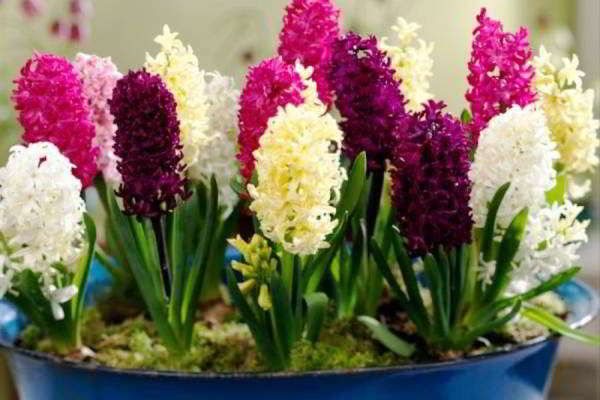

If your bulbs are ordinary and have not undergone special training for distillation, they should be stored in a dry place at 25-28 ° C. This is necessary for the formation of a new flower bud. After it forms, around September, the bulbs will need to be placed at a temperature of 17 ° C in a fabric or paper bag immediately until the very time of planting. By the way, pre-planting material must be dried within 2 days.
There are several ways to drive hyacinths out by March 8th. So, today it can be done as follows:
- at home;
- in a greenhouse;
- in water.
The most popular way to get hyacinth by March 8 is to cultivate it in a greenhouse. Forcing hyacinths by March 8 in a greenhouse will give you a large number of flowers for a relatively small financial investment. Home cultivation of hyacinths will not give you that amount, therefore, it is not suitable for growing them for sale.
Popular varieties and hybrids
Thanks to the efforts of breeders, indoor hyacinth has significantly changed in recent years. Plants with denser inflorescences were bred, double flowers appeared. Whites, blues, yellows and oranges have been added to the original lavender and carmine colors.
The genus of hyacinths has three types:
- Eastern hyacinth. It is he who is most often found in indoor floriculture. Differs in a thin peduncle; the flowers exude an intense, pleasant scent.
- Hyacinth Litvinov. The stem can reach 25 cm in height, the leaves are wide, bluish-green, the flowers are pale blue.
- Transcaspian hyacinth. Leaves are fleshy. The bulb can expel several stems with large, light blue flowers.
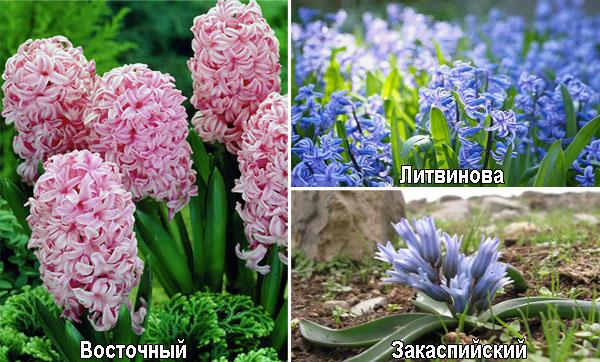

Oriental hyacinth, aka Dutch, became the basis for most of the varieties and hybrids that exist today:
- L'Innosance. The stem is medium, from 18 to 28 cm. Inflorescences are cylindrical; flowers are large (up to 4 cm), snow-white. The variety was created at the end of the 19th century and is still popular today.
- Madame Sophie. The inflorescence is narrow-cylindrical. The flowers are large, white, double. Arose as a result of a spontaneous mutation of the previous variety.
- Edelweiss. Peduncles are about 20 cm long, do not droop. The inflorescences are dense and wide. The flowers are snow-white, medium-sized.
- Anna Marie. Bright pink flowers are collected in a loose cylindrical inflorescence on a high (up to 25 cm) stem.
- Fondant. A hardy industrial variety with large peach-pink (up to 4.5 cm) flowers.
- Delft Blue. Large blue flowers on a short (about 12 cm) stem.
- Myosotis. The flowers are light blue, slightly elongated, with perianths twisted back.
- Amethyst. Inflorescences are wide, cylindrical; the stem is about 20 cm. The flowers are painted in a pleasant lilac-crimson color.
- Menelaic. A profusely flowering variety with black-purple tonal flowers.
- Jan Bose. The flowers are small (up to 3 cm), red-fuchsia, with a white throat.
- Hollyhock. It stands out with bright carmine-red double flowers.
- City of Harlem. A popular variety with large (up to 4 cm) light yellow flowers.
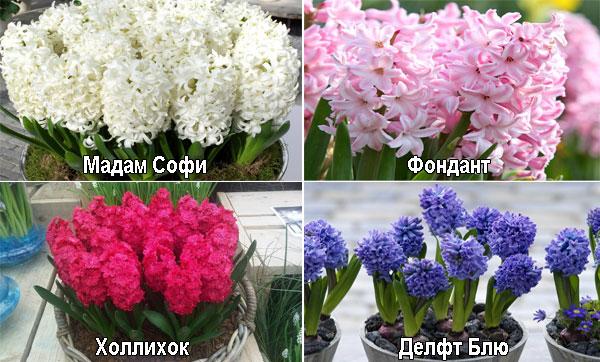

Among all the variety, it is easy to choose the variety that you will love.
How does it bloom?
Herbaceous perennial reaches a height of 20-40 centimeters. A peduncle sprouts next to the narrow linear leaves, and bloom on it flowers in the form of bells, collected in spike-shaped brushes, which are called sultans.
The flowering process is accompanied by:
- emitting a subtle aroma;
- the formation of short pedicels;
- the formation of a fleshy capsule-fruit of a spherical shape.
Inflorescences are different colors: blue and blue, lilac and lilac, white and yellow, red and pink, cream and even black.
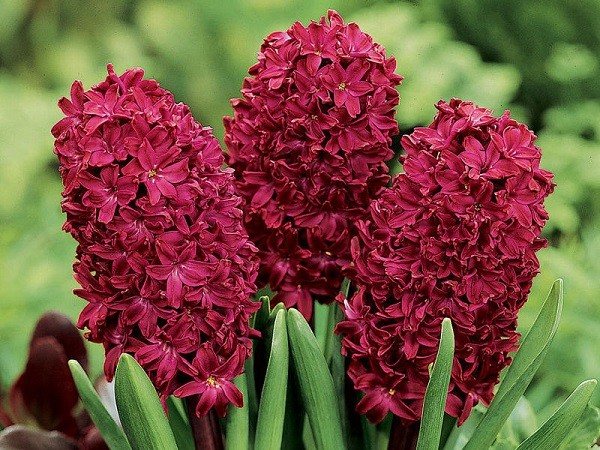

Flower history
In nature, hyacinth grows in the countries of the Mediterranean and Asia Minor. Wild representatives have a dull color of white, pink or blue.
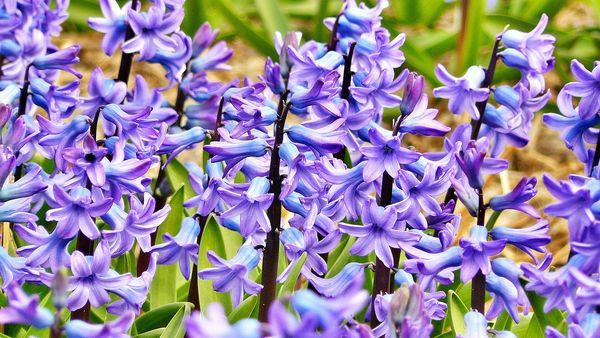

Since the 16th century, hyacinth began to win the love of Europeans. The Dutch were the first to grow bulbs.... They bred new species with bright and lush flowers and shipped them all over the world. Hyacinth was considered the flower of the real rich because the bulbs were sold at a very high price. Nevertheless, it has become very popular to grow such a fragrant decoration in the garden.
Later, hyacinth began to be cultivated in other countries. For example, in Germany, huge fields were allocated for its bulbs, and paid excursions were arranged on them at the time of flowering. The French came up with an inventive approach to the issue of cultivation and came up with an unusual method of planting: the bulbs were cut into 7-10 pieces, leaving the bottom intact, and placed in wet sand. A year later, up to 13 "kids" appeared.
In Russia, hyacinth appeared at the beginning of the 20th century and immediately fell in love with gardeners. Even then, it became popular to transfer the bulbs to the house for winter, and to admire the first flowering by the New Year and Christmas.
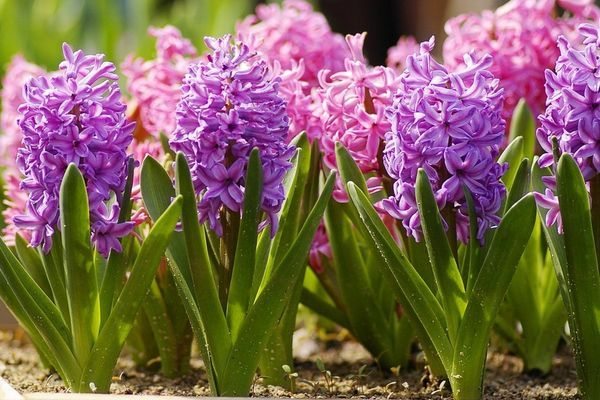

Nowadays main supplier of hyacinth bulbs - Holland, and almost everyone can afford such a flower.
Hyacinths have faded: what to do next with them?
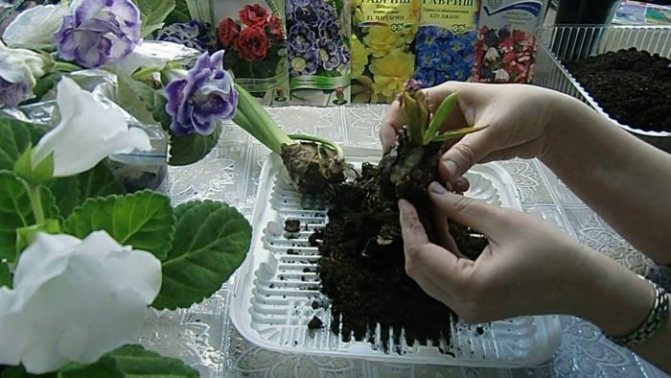

girl transplants hyacinth bulbs after flowering
When hyacinths have bloomed, their leaves and stalks wilt and fall off the bulb.
Leave the plants alone for the next 2 months to regain their vitality. The ideal option is not to touch the bulbs after flowering all summer.
Other options for action:
- cut off the wilted leaves and stalk with scissors and transplant the bulb with soil into a wide pot,
- Dig up the bulbs after the ground parts have fallen off and fold them into boxes in two layers. Leave them to dry in a cool room for a couple of months. Then change the temperature regime of their storage until cold,
- discard the bulbs if you don't feel like messing with them any further.
Landing dates
If you want to grow hyacinth in a greenhouse, you need to take into account some of the features of the flower:
- temperature regime;
- watering;
- light mode;
- top dressing.
The soil where hyacinths will grow and bloom should be nutritious and loose. Weeds and mice should not thrive in the greenhouse.
If the planting material was purchased in a package or in a specialized store, then they have already been treated with the necessary drugs to protect against diseases. Store them in a dark, well-ventilated area until planting.
Self-grown planting material can also be used, but only after it has undergone special training.
For distillation by March 8, the bulbs after digging are heated for two months at a temperature of + 25-30 degrees. After that, the temperature drops to + 17 ° C.
2.5-3 months before planting, the temperature is reduced to 8-10 degrees. Hyacinth is planted in an apartment for the holiday, taking into account the stages of development of the plant. This should be done around mid-October.
You can plant them a little earlier, in late September or early November. Growing at home lasts 4.5-5 months. The temperature is observed + 4-9 degrees, and from January 1 it must be reduced to +5 degrees.
For growing in a greenhouse, plastic boxes for storing vegetables are suitable. In it, you can drive out at once from fifty to 80 hyacinths. The substrate is prepared from a mixture of garden soil and sand in a 1: 1 ratio.
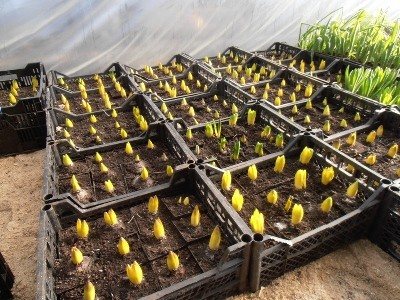

Photo: growing in a greenhouse
The sand must first be calcined to destroy all pathogenic bacteria. It is not recommended to apply nitrogen fertilizers, otherwise the plants will grow green mass, and flowering will slow down.
For better rooting, add 2 handfuls of superphosphate to a bucket of prepared mixture. And before flowering - any potash fertilizer.
The planted bulbs should be sprinkled with plenty of water with potassium permanganate (pink). Planting times in a greenhouse depend on the weather and are unlikely to be suitable for forcing for a particular holiday. The air temperature should be between + 4 ° C and + 9 ° C.
If there are a lot of boxes with plants, then they can be placed one on top of the other, and covered with an opaque cloth on top. When the bulbs begin to sprout, the material must be removed.
The soil should remain moist, watering should be done only when needed, about twice a week. To maintain high indoor humidity, the walls and floor are hosed.
Why don't hyacinths bloom or bloom poorly?
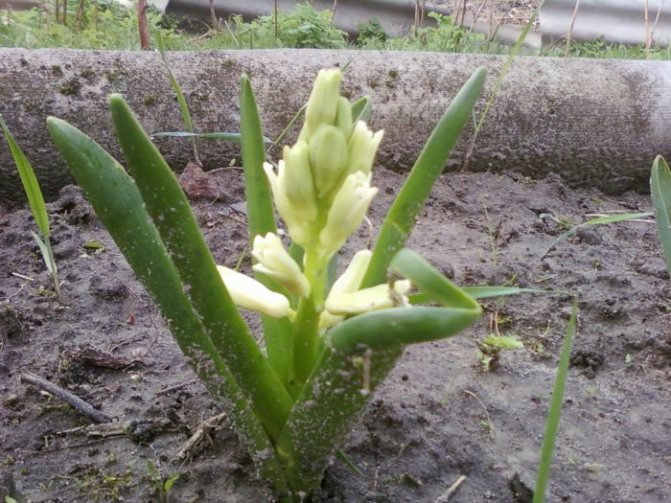

short-stalked hyacinth
There are several main reasons for this:
- bulb. She could get into the soil already sick or damaged,
- storage. Namely, non-observance of all the rules, poor-quality air humidification in the room,
- landing. Too early or late, to a greater or lesser depth,
- priming. Excessively hard and dry or sour and moist, with weeds during planting and budding,
- wrong choice of landing site. For example, the soil on which other bulbous plants grew last year is infected with diseases / pests, dangerous for hyacinths,
- lack of watering and sunlight in the right amount.
General information
Hyacinth is one of the brightest representatives of the Asparagus family. Earlier classifications attributed it to the Liliaceae or even separated it into a separate family. Its natural habitat is Greece, Turkey, the Balkans. The aromatic plant was especially popular in the Ottoman Empire, from where it penetrated to Europe. The ancient Greeks, delighted with the beauty and grace of the plant, associated a legend with its origin. According to the latter, Hyacinth was a friend of Apollo, who died due to the envy of the wind god Zephyr. Apollo grew a flower from the blood of a pet to perpetuate his memory.
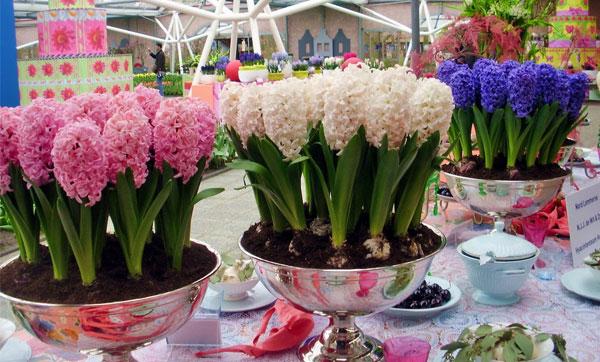

All hyacinths are perennial grasses with a dense bulb. The flowering stem, together with the leaves sitting on it, is a continuation of the bottom. After dying off at the base of the lower leaf, a bud is laid inside the bulb, which grows into a young bulb with the rudiment of a future flower stem. Flowers in the form of small bell-shaped funnels are collected at the tops of the stems in racemose inflorescences.
Hyacinth aquatic for aquarium water purification
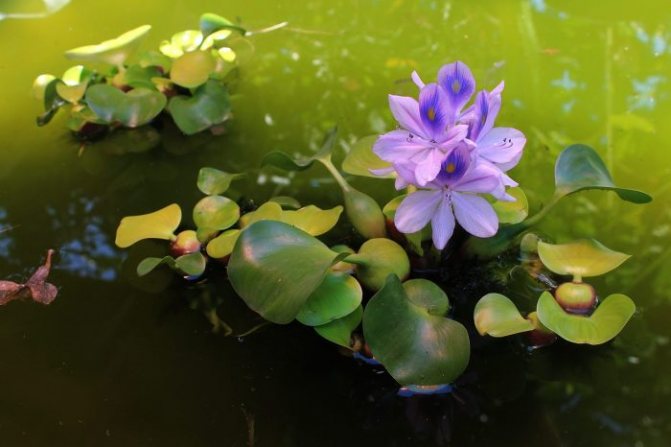

water hyacinth in a natural pond
Eichornia, or water hyacinth, loves water in different forms:
- vase
- pond
- aquarium
Its roots quickly remove turbidity and attract harmful salts that have already dissolved in water. This ability is extremely valuable for maintaining a harmonious aquarium environment. Due to the frequent topping up of water, you also add new substances that are not useful for its inhabitants.
Above the aquarium where the eichornia lives, be sure to set the lamp at a height of 40 cm so that the leaves receive enough light.
So, we examined the features of growing hyacinths in the open field and in a pot, its useful properties for cleaning water bodies. We got acquainted with the process of their reproduction and care.
Buy yourself this amazingly fragrant flower and befriend it!
Hyacinths: diseases
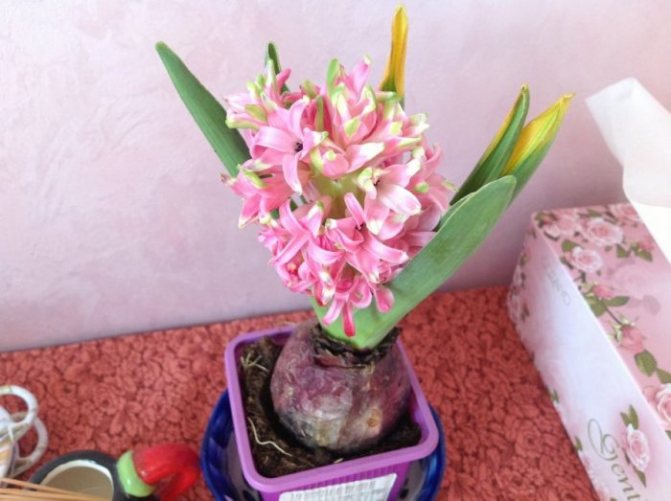

hyacinth is sick - it has yellow leaf tips
Hyacinths have diseases that are different in nature and causes. Let's conditionally divide them into two groups:
- physiological
- not physiological
The first are:
- peduncle curvature
- uneven blooming, when the upper ones bloom first
- the appearance of white buds
- green tops mixed with blossoming flowers
The second group includes:
- apical rot of an infectious nature
- bottom and root diseases manifested during storage
- soft or wet rot
Description
He gained popularity among flower growers thanks to a lush brush of flowers opening above the ground. Among the colors of hyacinth, a real extravaganza of colors rages: There are delicate whites and creams, as well as rich pinks, purples, reds and many other shades.
Hyacinth does not have a lush crown, but only 3-4 elongated fleshy leaves.They are bright green in color and grow directly from the top of the bulb. Thanks to the wide palette, you can create whole flower arrangements by planting several bulbs next to each other.
What is distillation?
Most novice florists are unfamiliar with the concept of forcing. Naturally, we need to talk about this in more detail. Without this knowledge, it is impossible to breed a plant either for yourself or for sale.
Forcing hyacinths is a set of actions, by implementing which, you can accelerate the growth of a flower, thereby guessing the flowering time by a certain date. This method is widely used in floriculture. Ideal for greenhouse cultivation. During distillation, special conditions are created: a certain temperature regime, an optimal humidity level, additional lighting. This promotes vigorous growth and flowering. This is how hyacinth in a pot and other bulbous crops (lilies, tulips) are grown.
Having figured out what distillation is, it's time to move on to practical actions. Further, detailed instructions will be presented that will help you grow beautiful flowers on your windowsill.
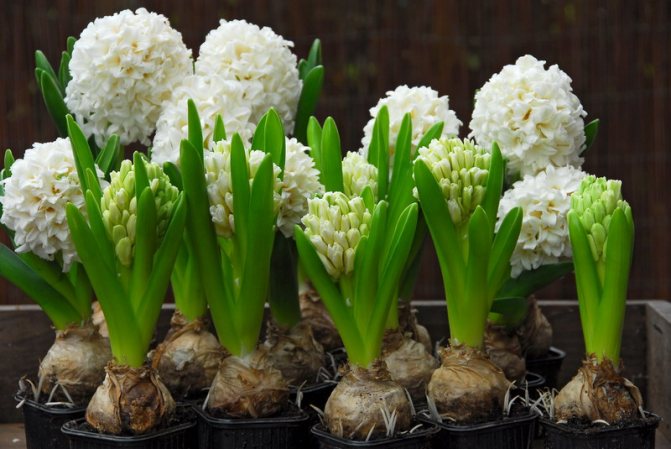

When do hyacinths sprout, when do they bloom, how many times do they bloom?
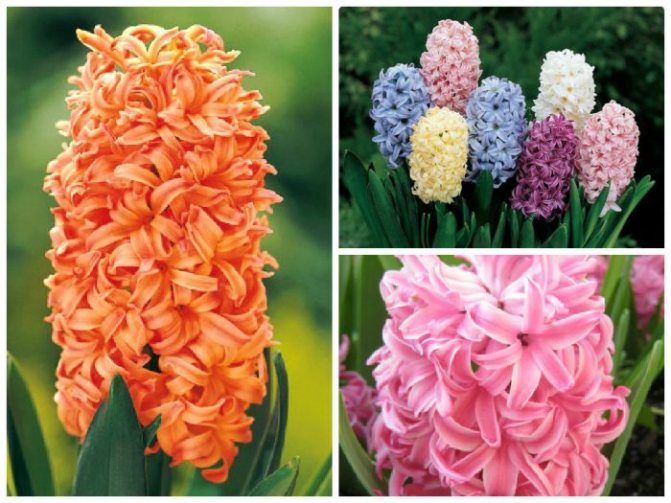

blooming hyacinths of different shades
Hyacinths bloom only once a year. During this period, their bulbs are so depleted that they are no longer able to please with beautiful flowers.
Plants living in open ground bloom in the spring with the arrival of the first heat and rain. The end of March and the beginning of April are their months.
Indoor hyacinths are ready to bloom at the time of your choice. Of course, pay attention to their varieties before planting. Therefore, they dissolve in:
- late December
- January-February
- first spring months
How to regulate the rate of peduncle development
If you understand that the hyacinth will not bloom by the date you specify, you can speed up the process by adjusting the temperature and lighting: the temperature is increased by 2-3 degrees, the daylight hours are increased to 12-16 hours. You can slow down the development of the inflorescence by reverse measures: reduce the daylight hours or transfer the flower to partial shade, while lowering the temperature in the room by a couple of degrees. In cool conditions, the flowering of hyacinth lasts up to two weeks, and if the peduncle is strongly stretched, it is tied to a peg stuck next to the bulb.
Popular types of hyacinth
A description of hyacinth varieties with a photo will help you choose a bright and beautiful decoration for your window.
Oriental
The most common hyacinth, it adapts well to different climatic conditions. There are 3 varieties:
Dutch the subspecies grows up to 25 cm, releasing a single peduncle about 5 mm in diameter. Leaves are smooth, uniform light green color. The racemose inflorescence is formed by small bell-shaped buds. The color scheme is diverse: pink, yellow, white, lilac, blue. Breeders have bred more than 400 varieties of this hyacinth subspecies.
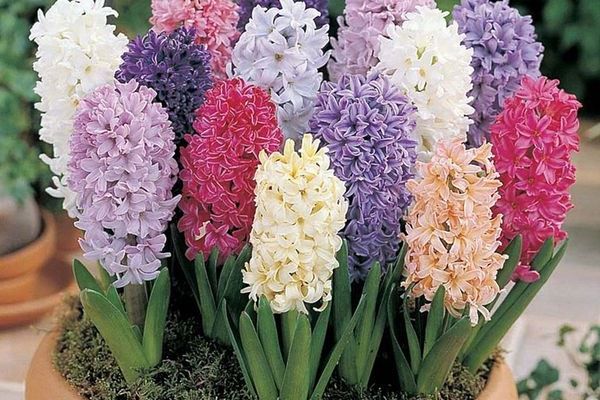

Whitish hyacinth suitable for garden plots, growing up to 65 cm. 3 peduncles grow from the bulb at the same time, bordered by lush white inflorescences, the buds hang like bells. The flowering period occurs in southern latitudes in June; in temperate regions, flowers appear in August.
Provencal the subspecies is singled out separately for the pink color of flowers.
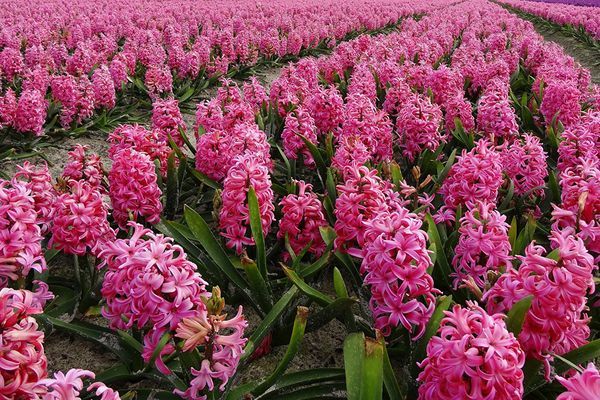

Transcaspian view
It is found in some mountainous regions of Turkmenistan at an altitude of 1000 to 2000 meters. Only in the fifth year of growth, the Transcaspian hyacinth produces 2 or 3 stems with blue inflorescences. Propagated by the formation of seeds in special boxes.
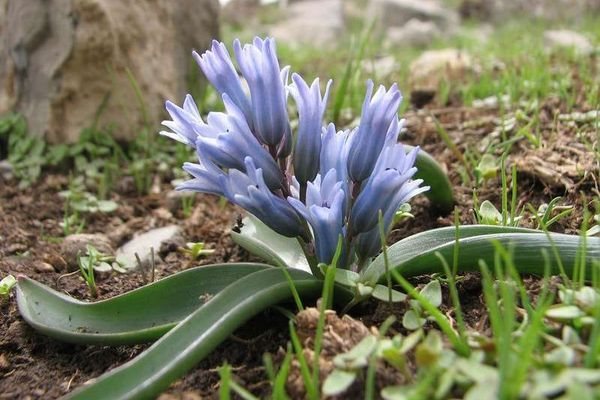

Hyacinth Litvinova
A description of the wild species was given by the Russian geographer D.I. Litvinov. In the natural area of Turkmenistan, Turkey, Libya and post-Soviet countries, it is listed in the Red Book. A short hyacinth with thin and wide leaves grows no more 25 cm, forms several peduncles.The buds are colored in shades of blue, pink, purple or white. Hyacinth Litvinov has no scent.
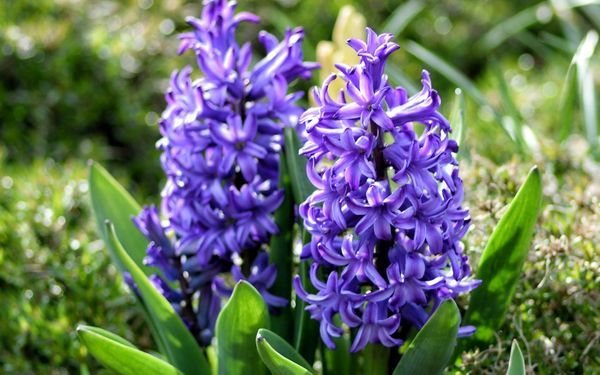

Since the last revision of the botanical classification of plants, mouse and aquatic species are no longer considered hyacinths.
Reasons for unsuccessful distillation
Why distilling hyacinths can fail? There are several reasons. Here are the main ones:
- Excessive watering, which causes the leaves to wilt.
- If during the dormant period all the requirements were not met, the peduncle has a small height.
- Leaves change color to yellow in the presence of drafts or lack of light. During the flowering period, the duration of daylight hours should be up to 15 hours.
- The buds crumble with irregular watering.
- The peduncle does not appear if a weak bulb or a very small bulb was chosen for cultivation.
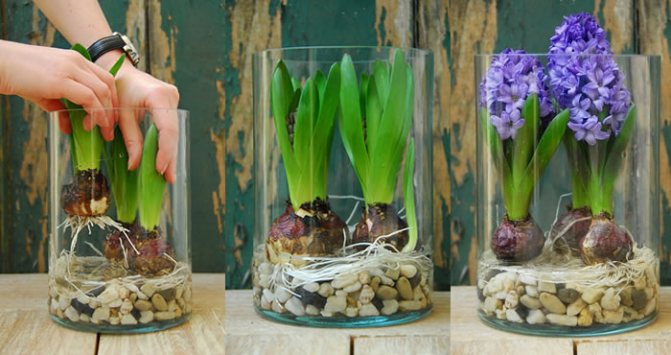

Hyacinth: how often to water in the pot and in the garden?
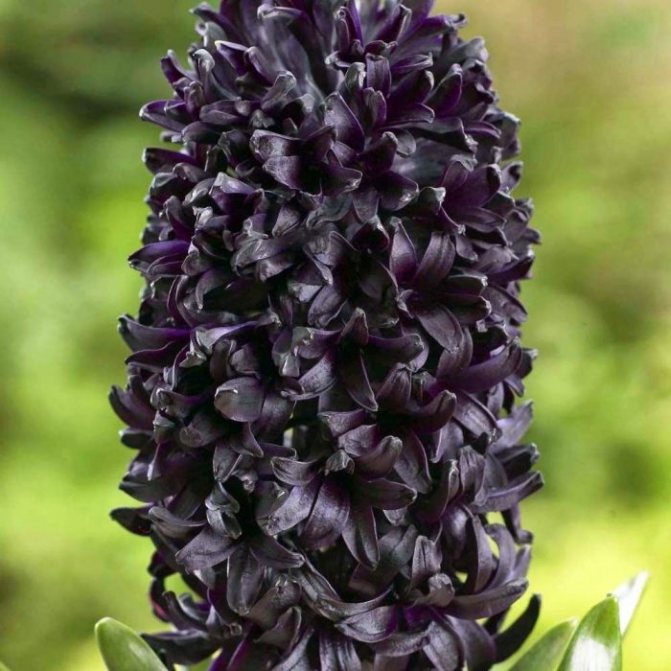

black hyacinth blooms due to good watering
Hyacinth means "rain flower", which means it loves moisture that does not stagnate.
When planting in a pot, sand will become an indicator of soil moisture. Sprinkle it on top of the onion and check after 3-4 days. Teach that during rooting, the hyacinth is in a cool place, so the moisture will not evaporate quickly.
After the buds appear and the temperature changes to the plant, water it more often. But still focus on the top layer of sand.
If you decide to breed hyacinths in the garden, then immediately after planting in the ground, water them abundantly.
In the spring, when buds appear on the bulbs, check the soil moisture. If it is dry, then water is needed.
Forcing in the greenhouse
Hyacinths are those bulbous flowers that are perfect for growing in a greenhouse. Under its conditions, forcing will be more successful, since there is an opportunity to create all the necessary temperature conditions.
Also, when cultivating hyacinths in greenhouse conditions, you need to take into account some of the nuances of planting this plant and the features of caring for it. Hyacinths are very demanding on conditions such as:
- fertilization;
- watering;
- lighting.
You also need to remember about the composition of the soil in the greenhouse where the hyacinth will be grown. It is necessary that it is well fertilized, loose, and free of all weeds. The ideal soil will be one that is characterized by good air and moisture permeability. Even in the selected soil, the presence of pests and various pathogenic bacteria should be excluded.
Experienced commercial gardeners say hyacinth is the optimal crop for mass forcing. Even inexpensive (small) bulbs produce flowers of pretty good quality. Plus - the plants bloom evenly. A suitable container, according to the experience of one of these growers, is industrial planting pots measuring 9 * 9 * 10 (about $ 0.07 per piece).
Agricultural technology in a greenhouse is massive, so it makes sense to run the entire cycle on a trial batch, and take into account all the recommendations given in this article in relation to your capabilities.
How to properly prepare the soil for planting
For distilling hyacinths, light, loose soil is required. It can be purchased at specialized outlets or prepared on your own. For this, earth from the garden, peat and coarse sand are combined in equal shares, everything is thoroughly mixed. For acidic soil, add dolomite flour according to the instructions on the package.
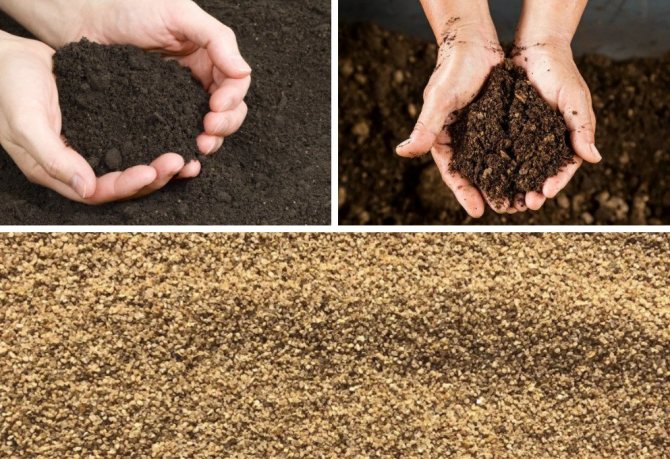

The substrate is poured into a pot, leaving a third of the height empty (not forgetting about the drainage layer), slightly compacted and watered. Additional additives are not added to the planting soil mixture, since all the necessary nutrients are already contained directly in the bulb.
Diseases
Having figured out how to care for a hyacinth at all stages of its development, you need to be prepared to deal with possible problems. The bulbous plant is resistant to adverse conditions, but there is a risk of diseases:
- Bacterial rot. Most often it is provoked by stagnation of water in a pot, manifested by softening and decay of the bulb. Before that, dark spots may appear on the leaves or the roots may dry out. It is almost impossible to cure such a disease; it is easier for prevention to carefully observe the watering regime.
- If the leaves begin to turn yellow and dry before flowering, then they must be examined for the presence of parasites. Aphids or spider mites suck the sap out of the plant and lead to similar problems. It is necessary to spray with an antiparasitic solution for indoor plants until the inflorescence begins to form.
- In case of insufficient lighting or the absence of fertilizing, weak flowering or deformation of the peduncle may be observed.
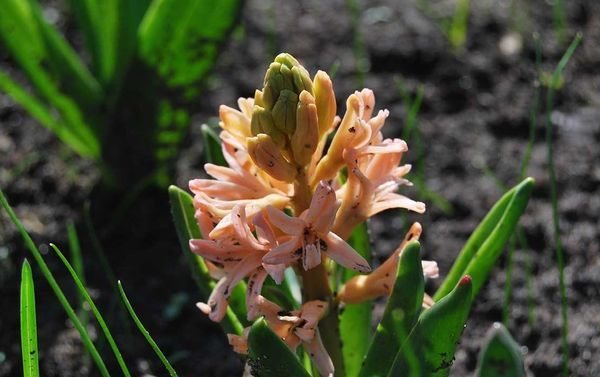

Preventive measures
Hyacinths are distilled using healthy bulbs only. Before planting, they are carefully examined for signs of decay and insect damage. In order to avoid contracting a fungal infection, it is important to do a simple manipulation. It is recommended to immerse the onion to be used for forcing in a weak manganese solution. The duration of the procedure is 5-10 minutes.
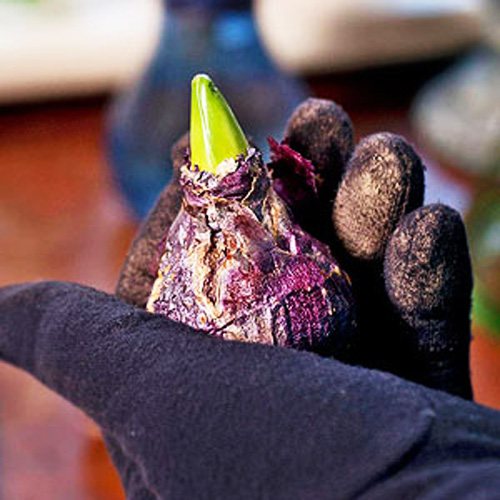

Optimal conditions for the plant
What you need to provide hyacinth in order to achieve a beautiful flowering:
- Bright, diffused lighting (do not allow direct sunlight to hit the plant);
- Temperatures up to 22 ° C;
- Regular watering;
- Top dressing using complex fertilizer for flowers.
A support should be created for the plant, since its peduncle during flowering has a rather large weight, which can lead to a tilt of the stem or even to its breakage.
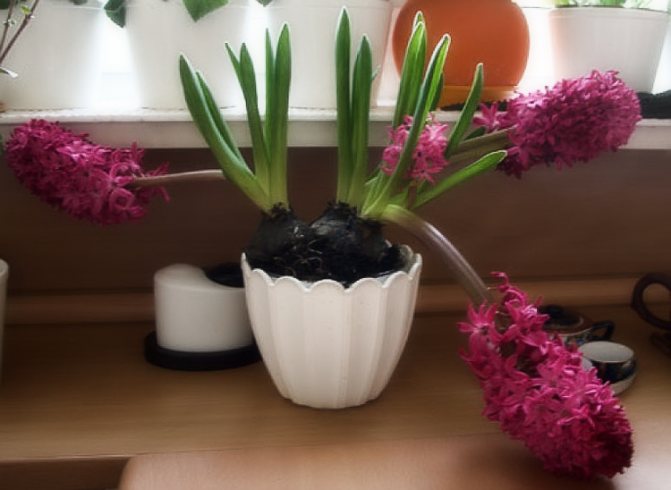

By creating cool conditions for the plant, you can extend its flowering by more than 20 days. This will also help preserve the bulb. So that it does not become a one-time use, from the moment when active growth began until flowering, it is recommended to cover it with a small layer of snow. This procedure will strengthen and harden the bulb.
If the flower is in a hot environment, this will significantly shorten the flowering time and weaken the bulb.
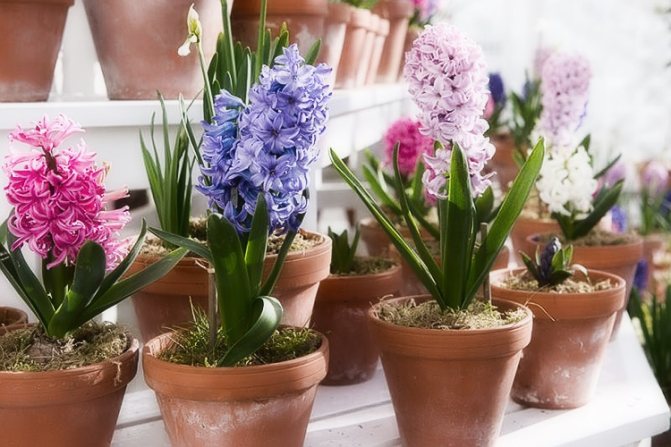

Watering and feeding
In winter and spring, you need to carefully monitor that during the distillation, the substrate does not dry out, otherwise the growing roots will raise the bulb and fill it to one side. Therefore, watering is needed regularly and in small portions. When a plant enters the dormancy stage, it is practically reduced to a minimum. A withered plant is not watered at all.
Hyacinth feeding is carried out systematically. For plants whose bulbs are at a dormant stage, poorly dissolved phosphorus-potassium fertilizers are required.
During flowering, formulations are used for feeding, with the help of which the plant is stimulated.
Secrets of transplanting a flowering culture
The plant should be repotted after it has faded.
- To do this, you need to cut off the peduncle and choose a more spacious container, on the bottom of which you can put expanded clay or sand.
- Then, using the transshipment method, without damaging the root system, move the hyacinth, pouring fertile soil around the edges.
- It is important not to deepen the bulbs. About a third of it should be above the surface.
- Pour a small layer of sand 1 cm thick on top of the soil.
Transplanting into a pot involves placing the plant in a well-lit and cool room. Hyacinth will not keep you waiting long and will quickly delight you with new green foliage. In the future, it will be natural to organize the proper care and development of the transplanted plant.
To grow beautiful and strong indoor flowers, you should take proper care of them, know how to transplant them at home and protect them from possible dangers. And then the flowers in pots, surrounded by attention, will decorate the apartment with bright flowering and elegant appearance.
Propagation of hyacinths: bulb, seeds, leaves
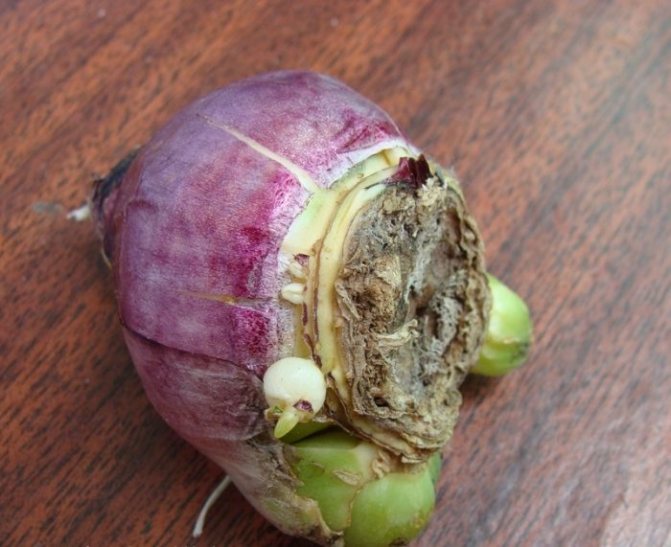

grown babies on the mother's bulb of hyacinth
Bulb propagation of hyacinths is common and available to gardeners of all skill levels. Unlike the other two methods, which require patience, attentiveness and a good knowledge of plant development.
During flowering, 2-8 babies are formed around an adult bulb. Select them and plant them separately, but they will amaze you with flowers only after 3-5 years.
During the formation of buds of future flowers on the hyacinth, carefully cut off 2 leaves and place in a special aqueous solution for 10 hours. Then transplant into wet sand and leave in a warm room with diffused light for 1.5-2 months. During this period, the leaves will take root in the form of small bulbs and filaments and young leaves. Change the soil under the plants to a more nutritious one. You can get up to 10 children from one sheet.
Seed propagation is used by breeders to create new varieties of hyacinths. The process of growing them is extremely painstaking and long. You will get a full-grown flowering plant no sooner than 8 years later.

